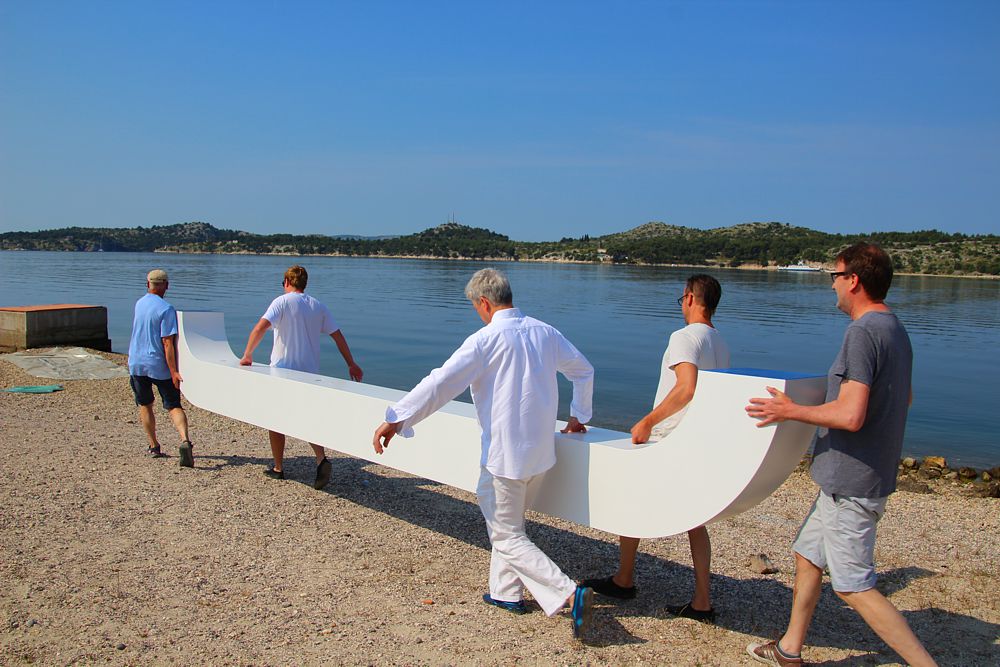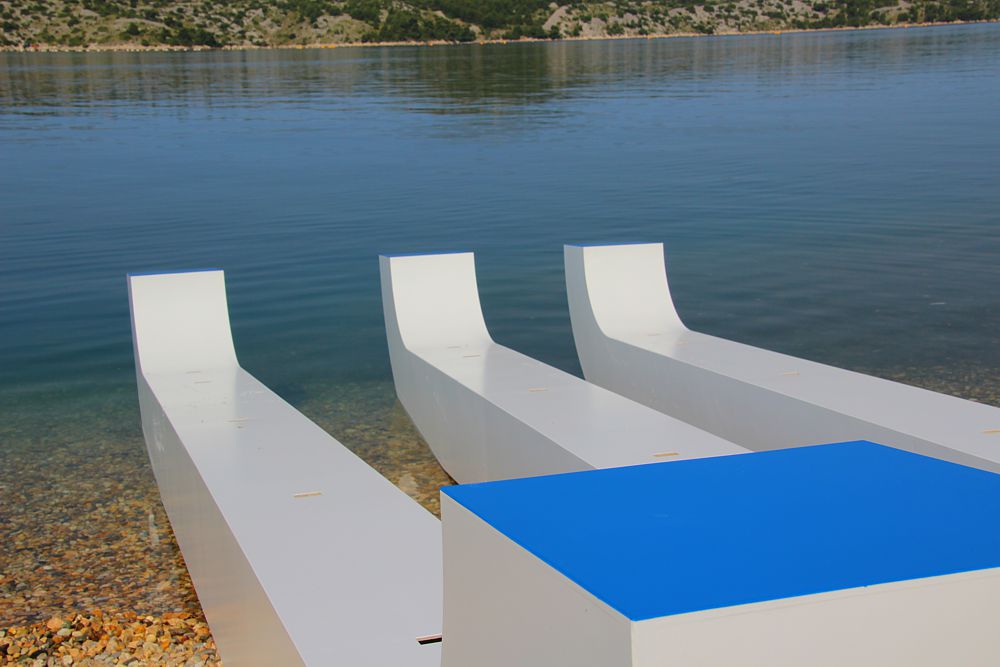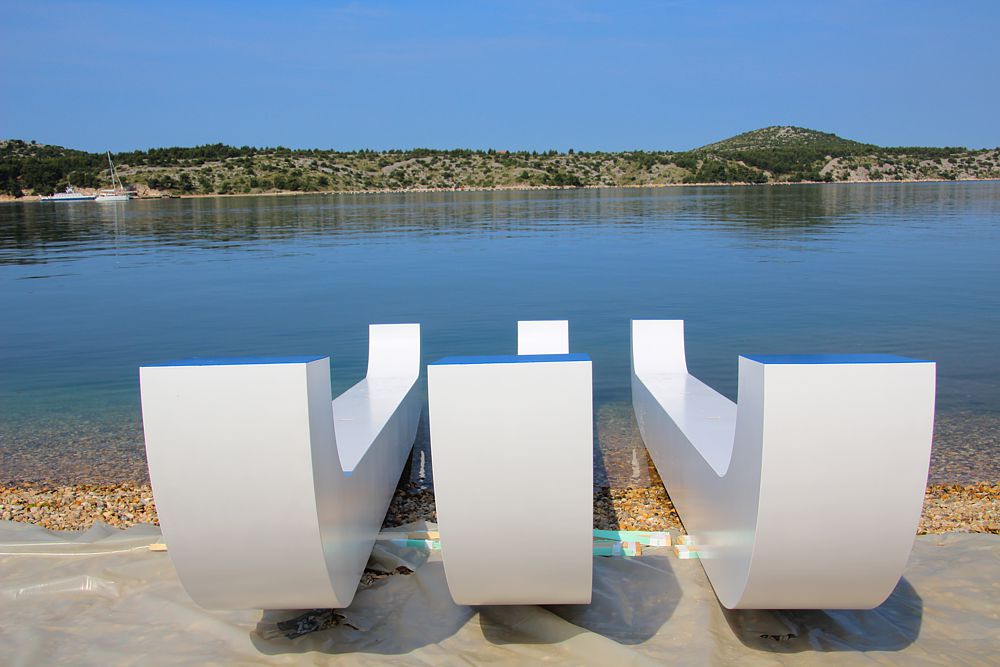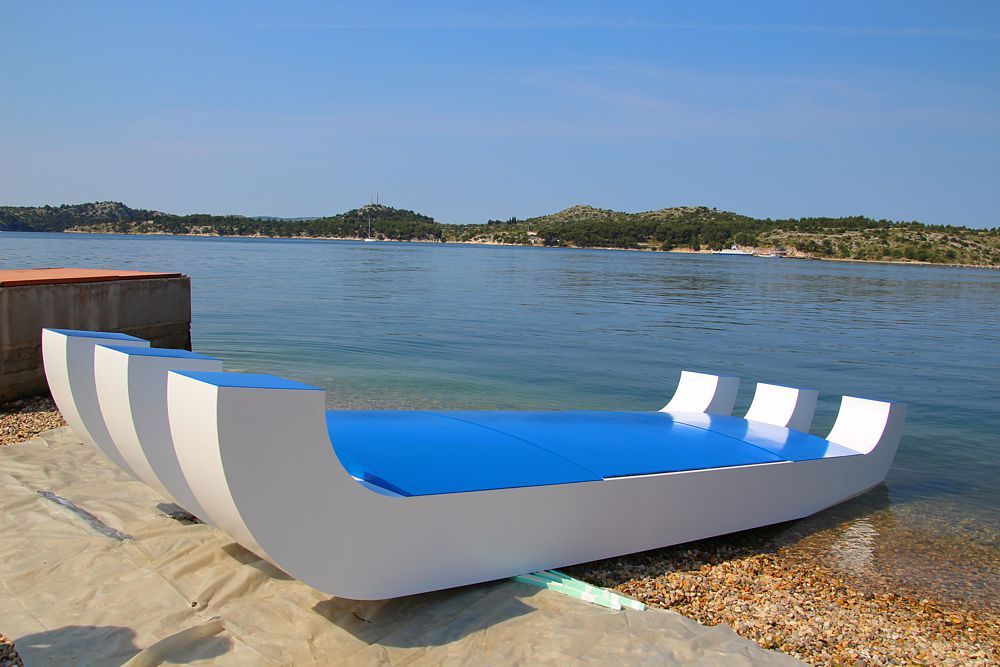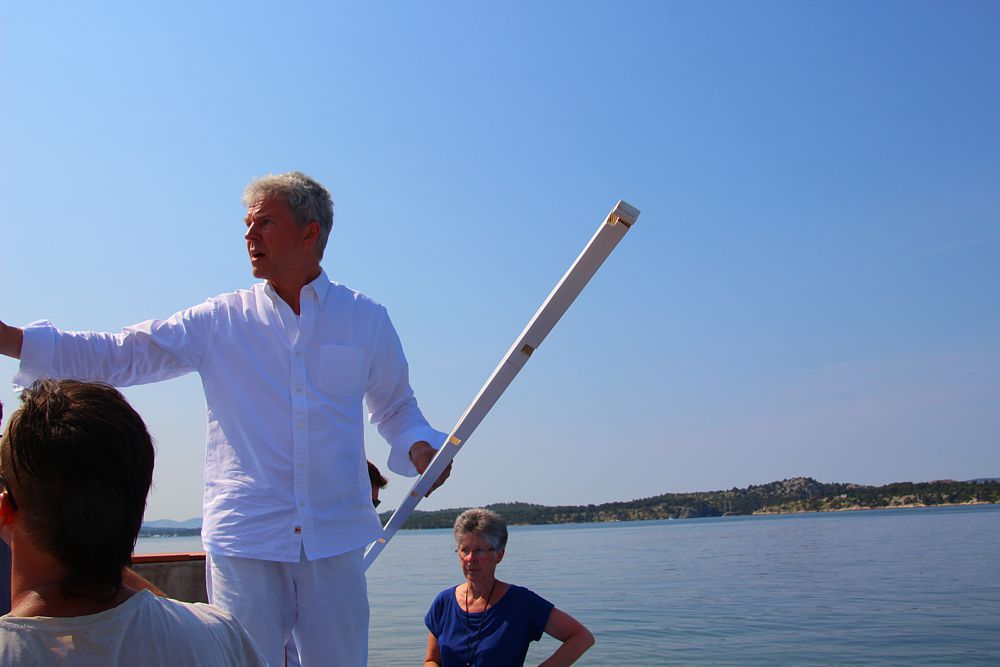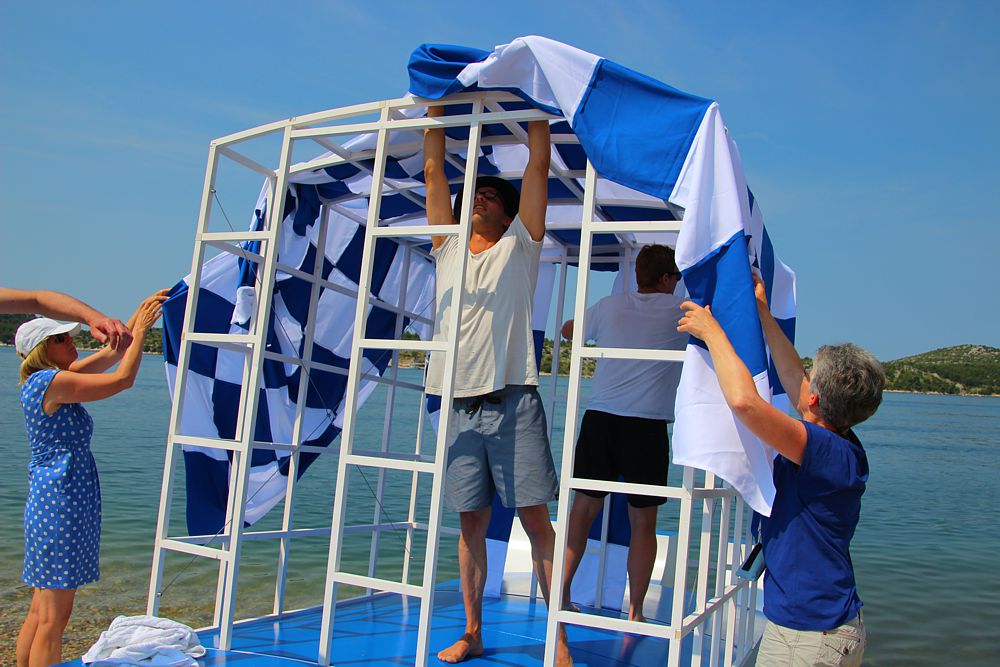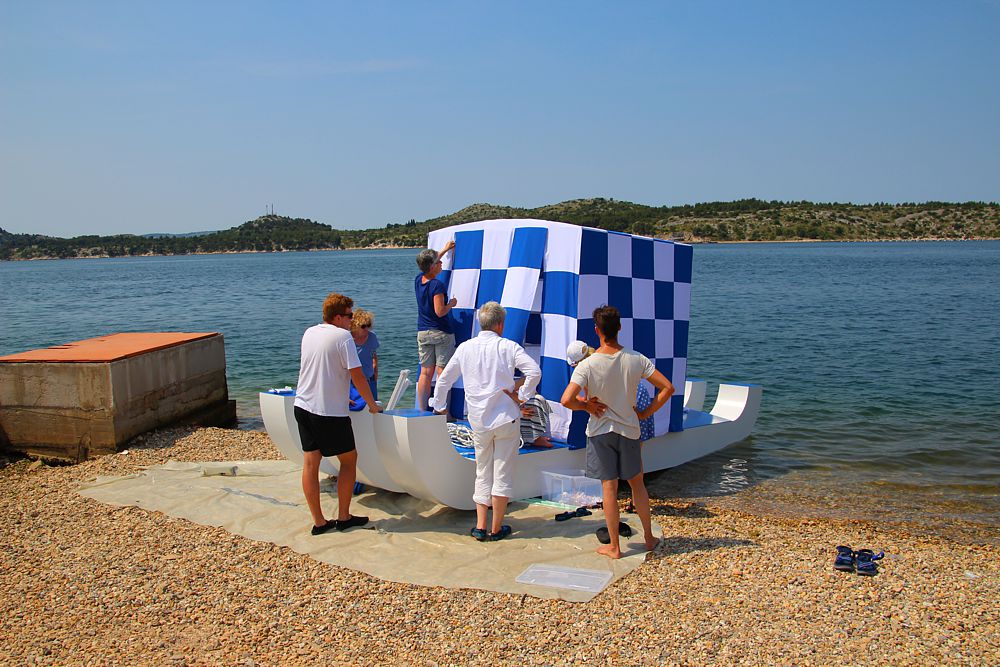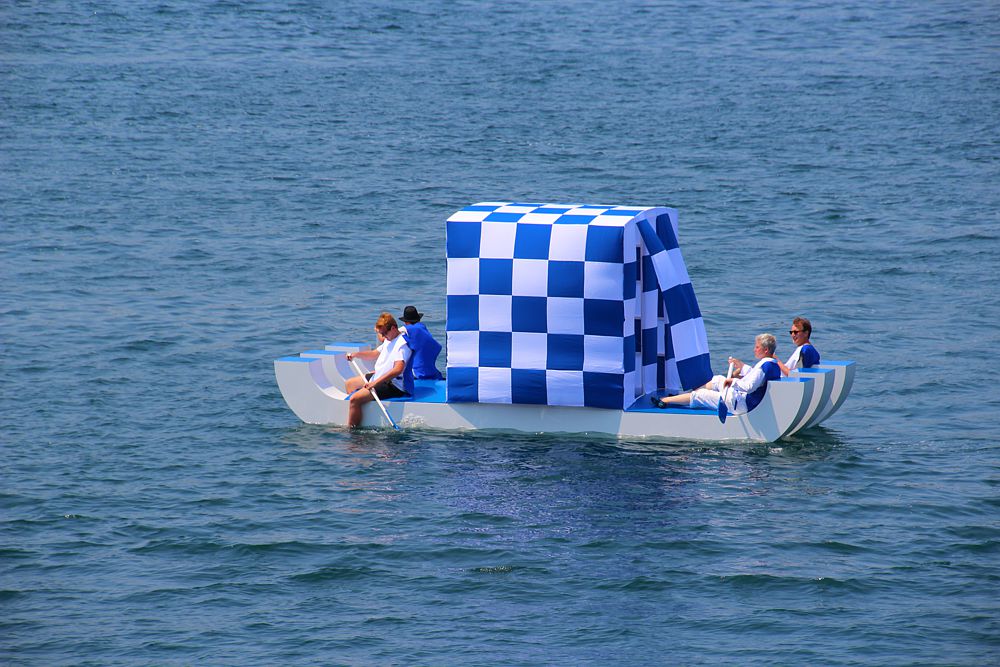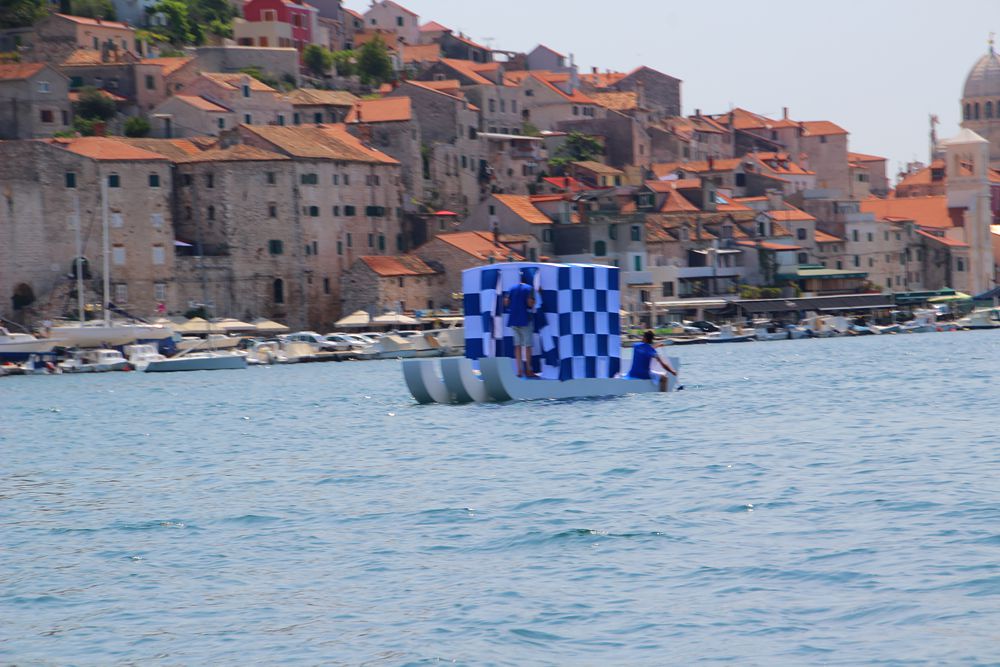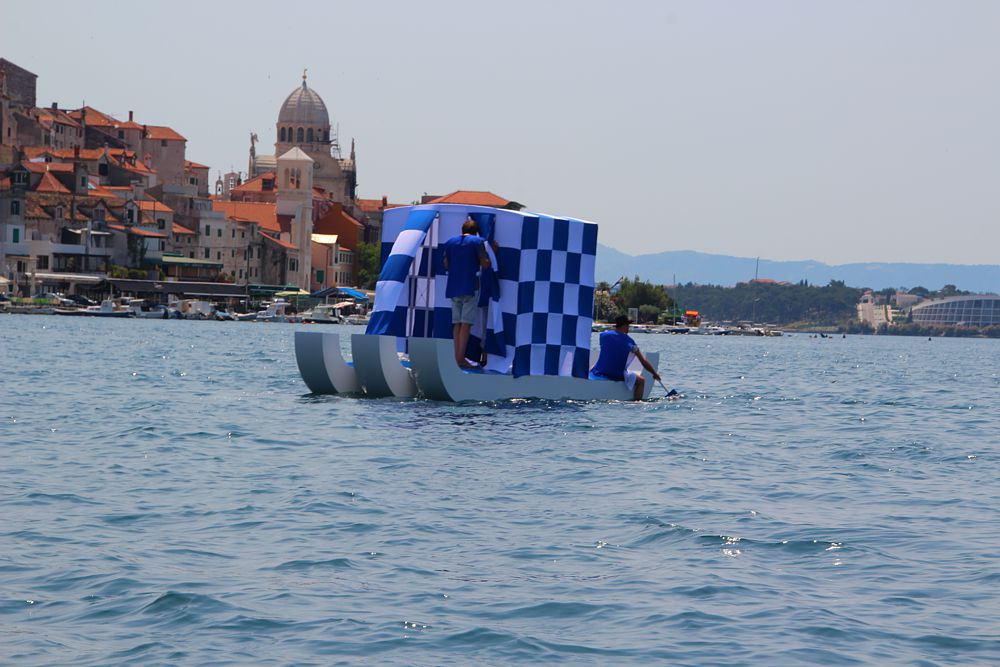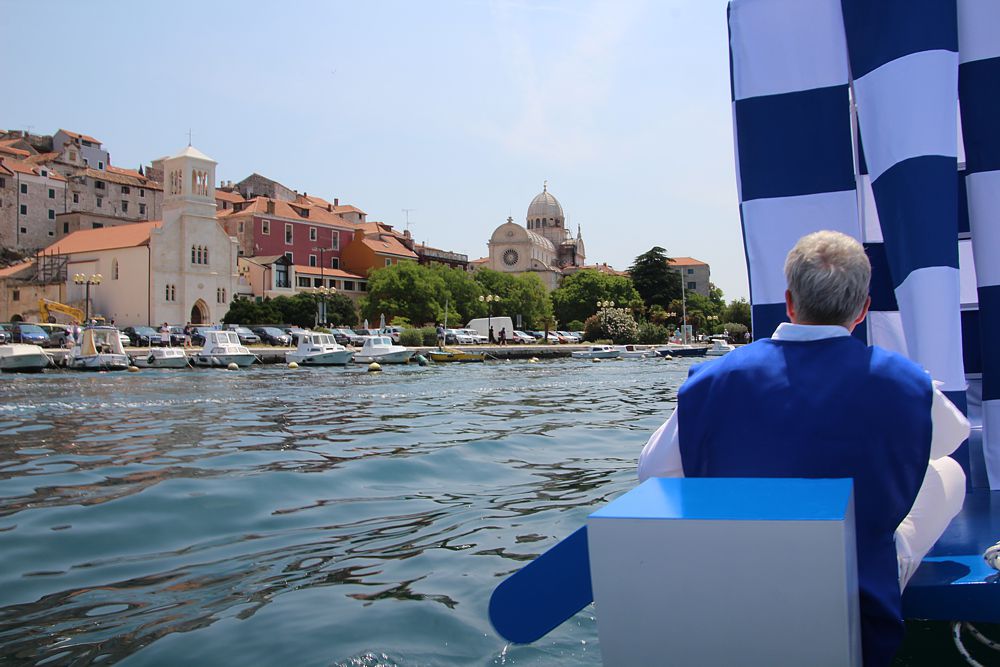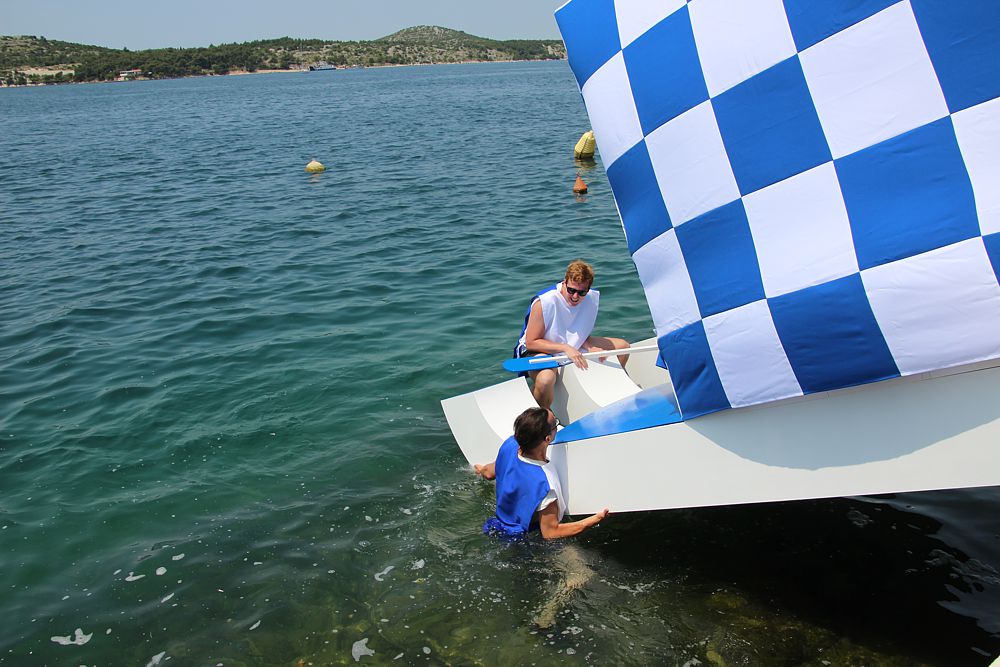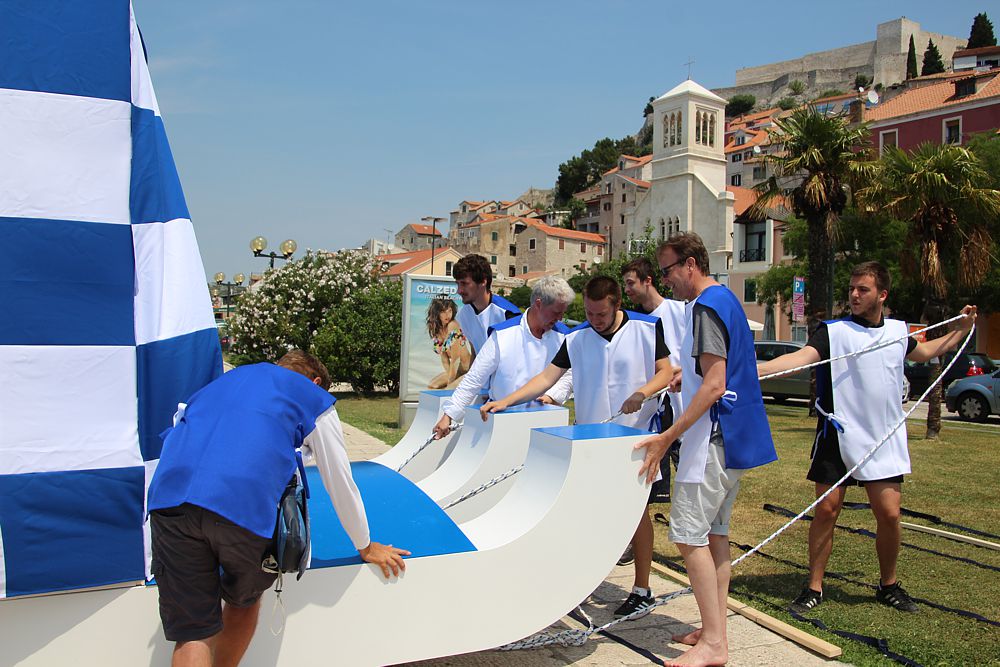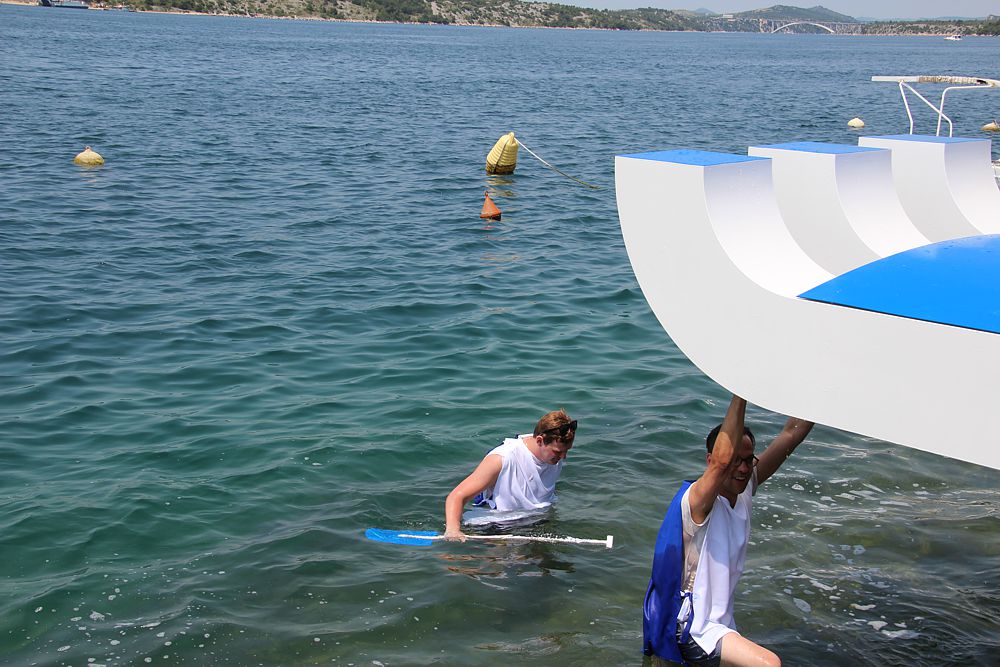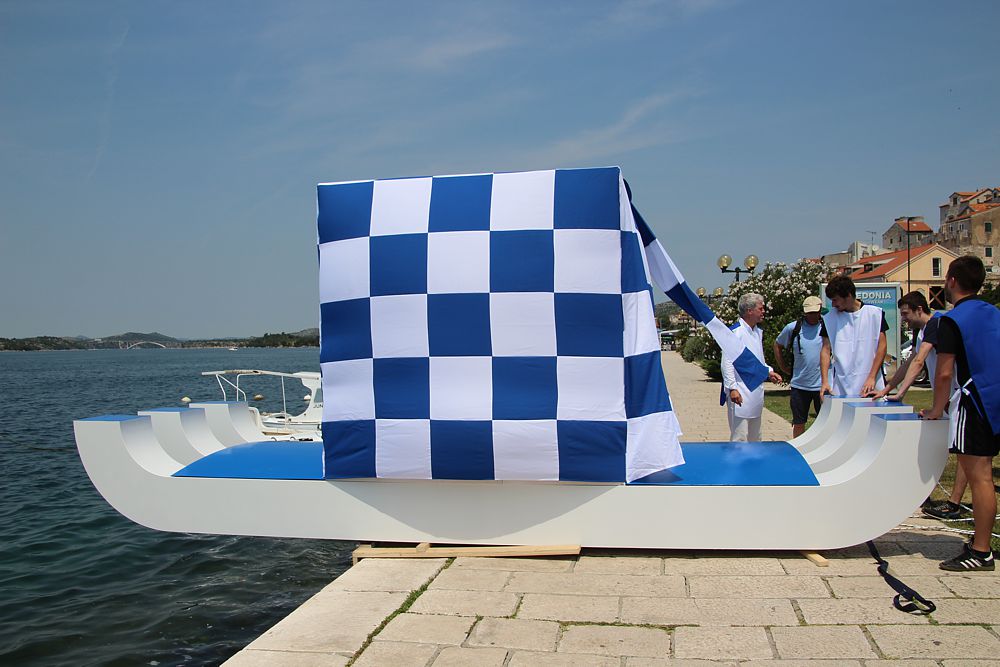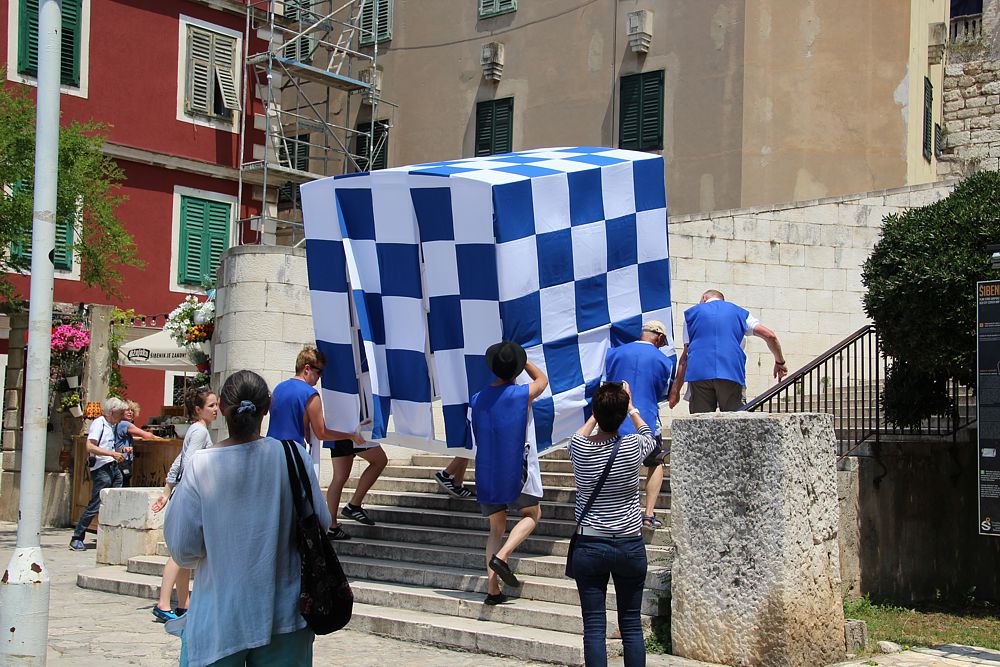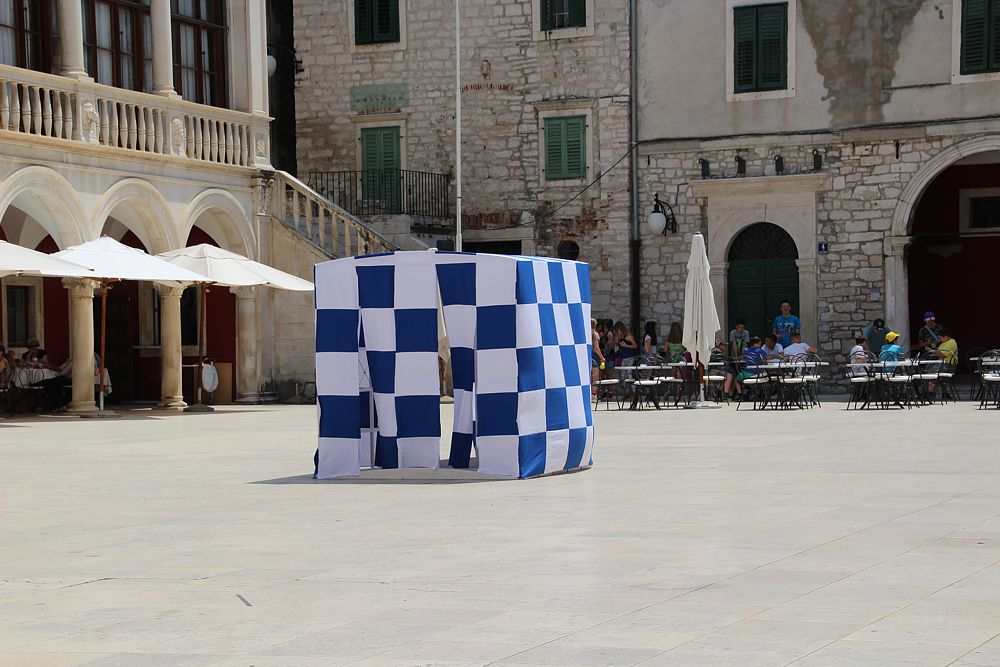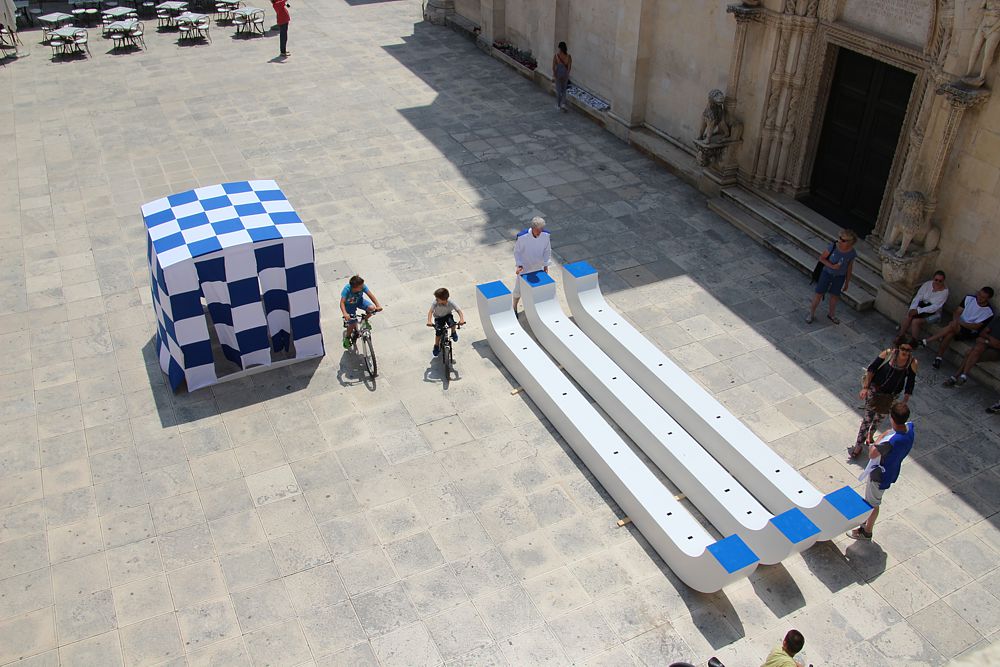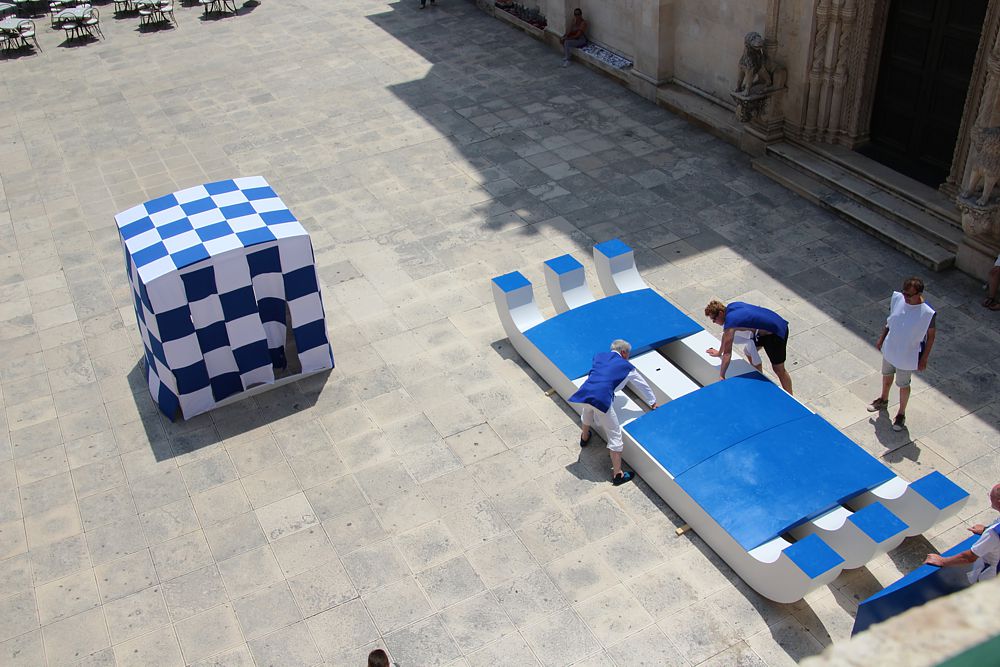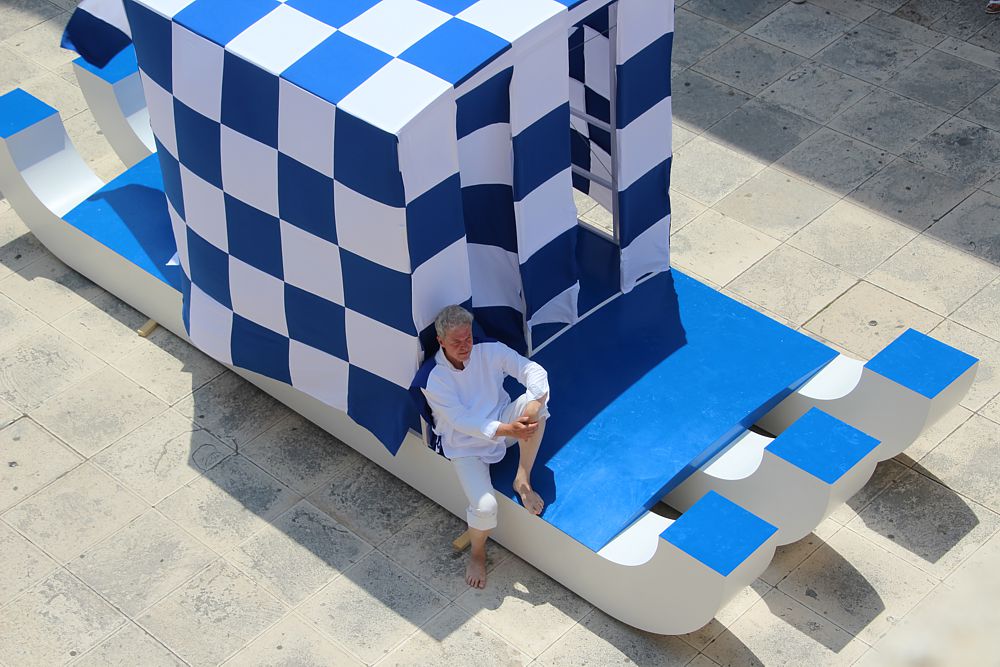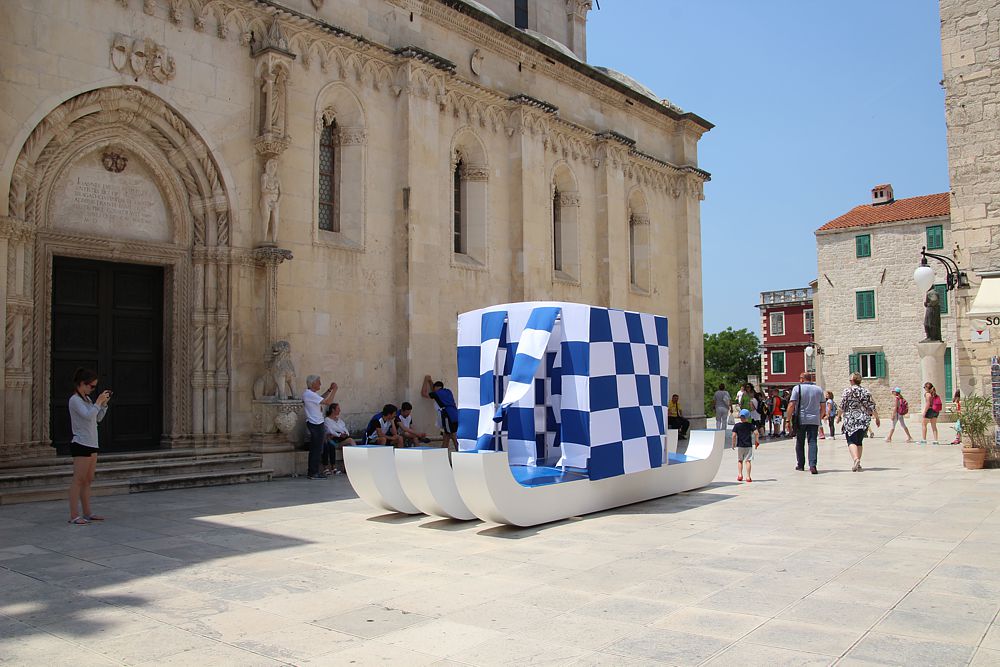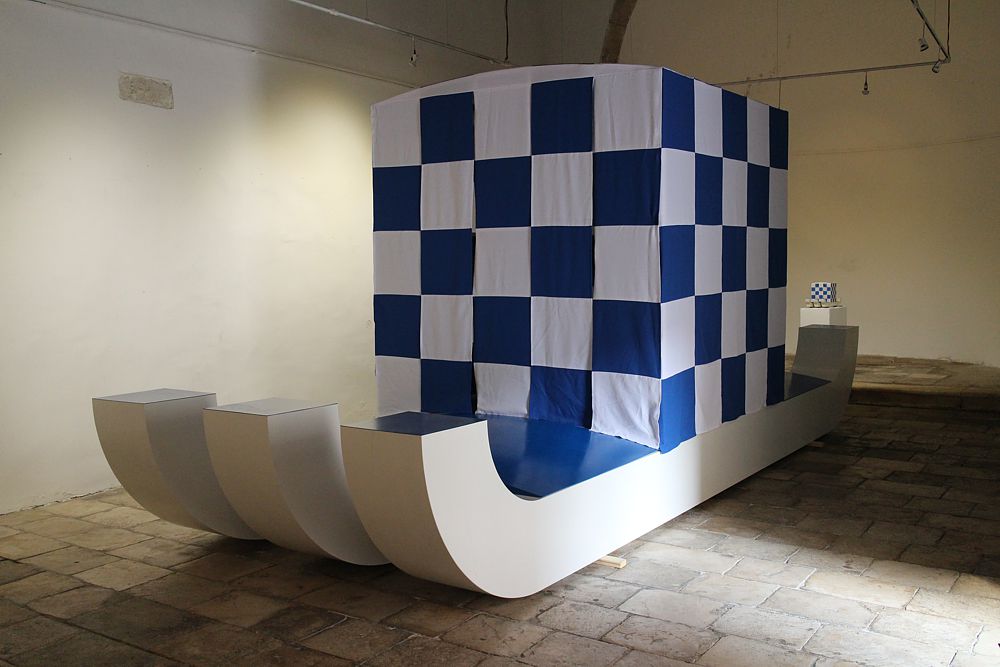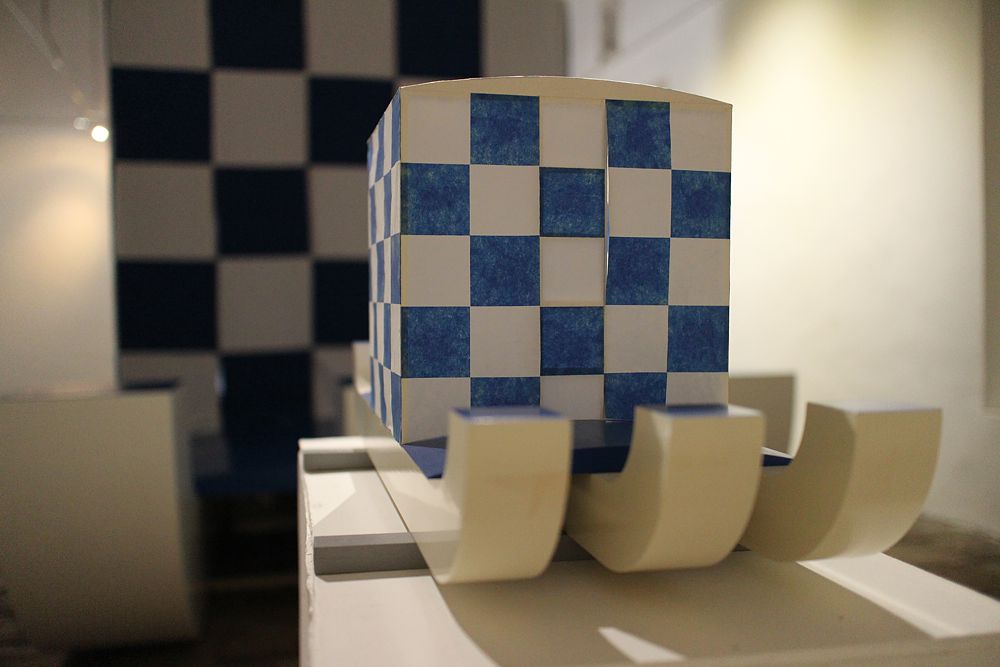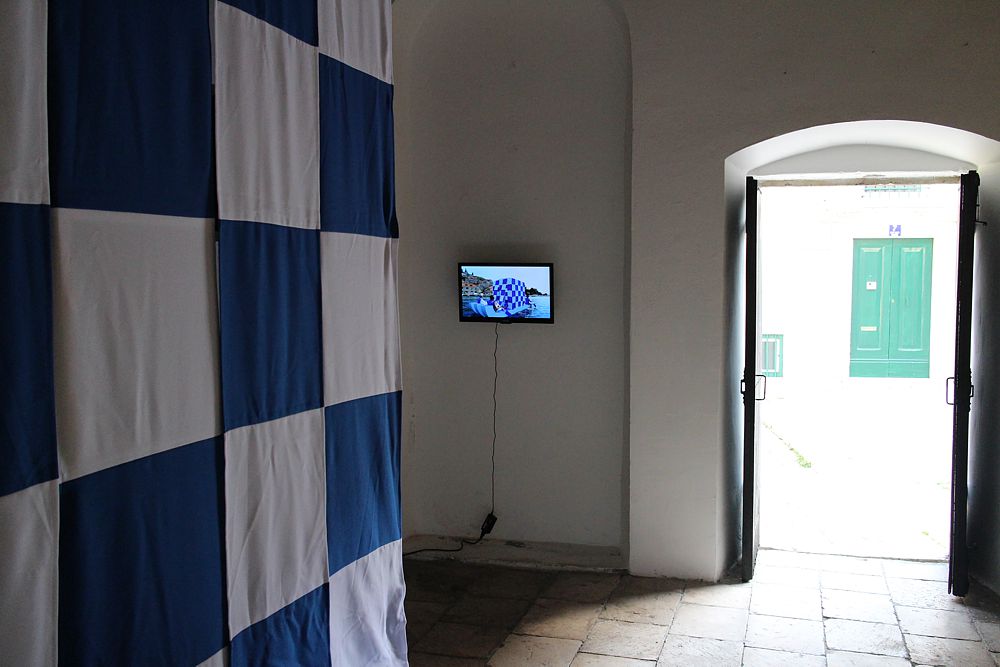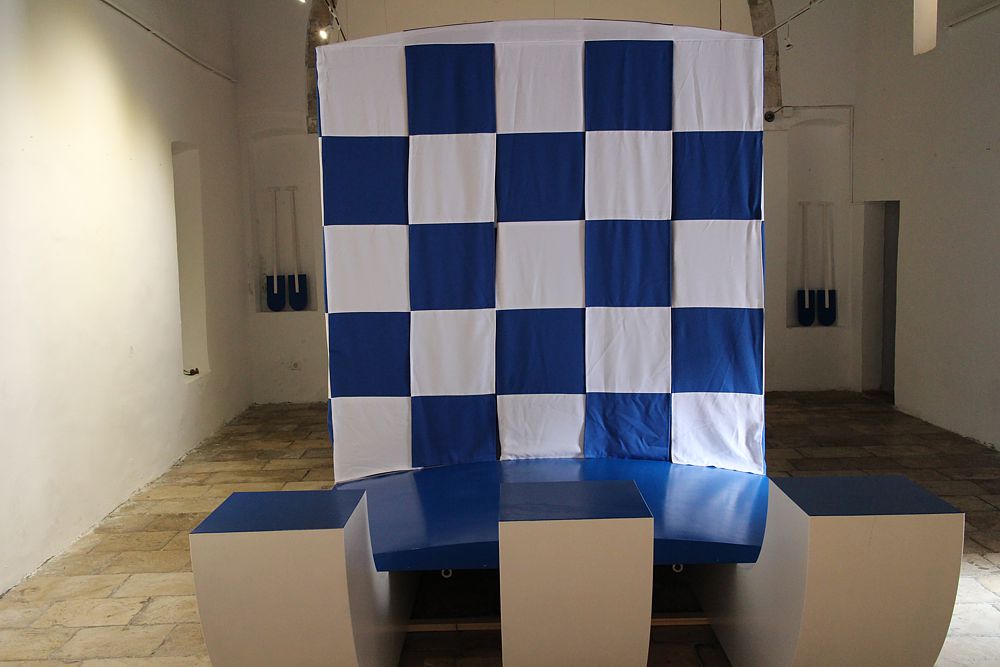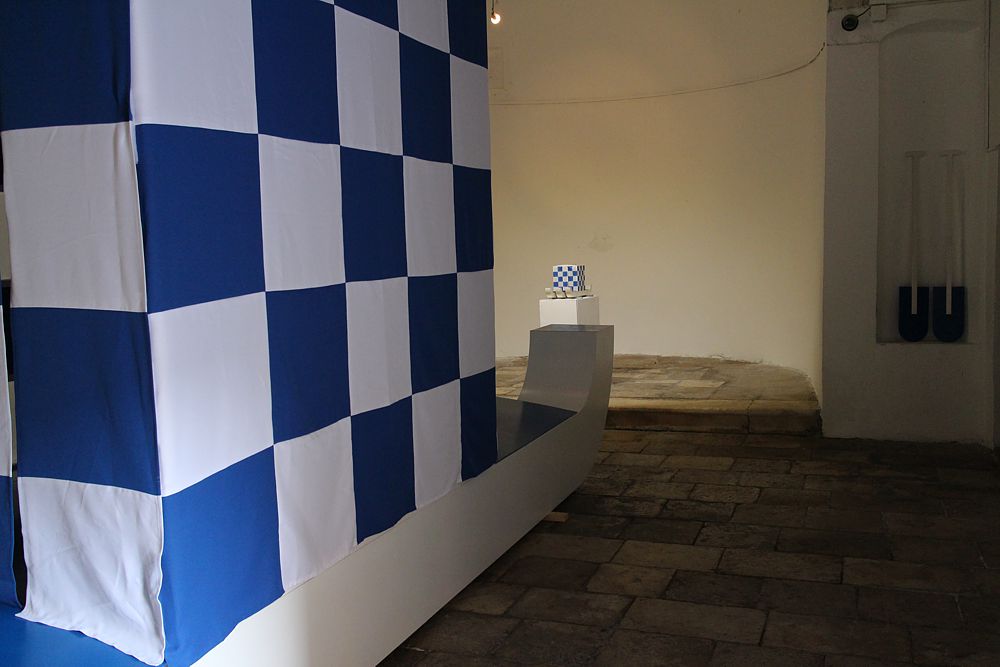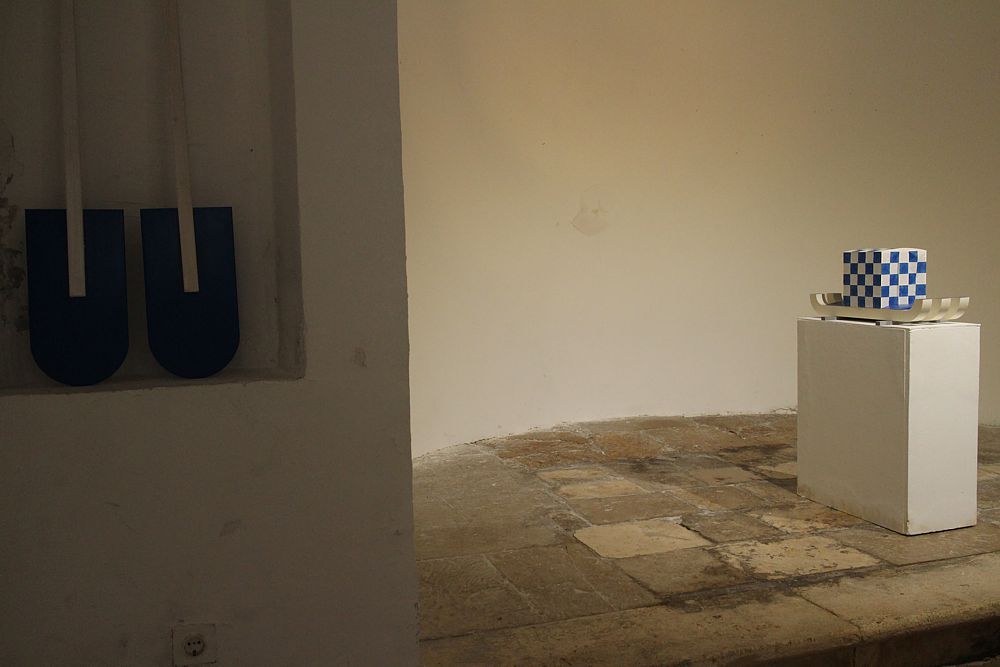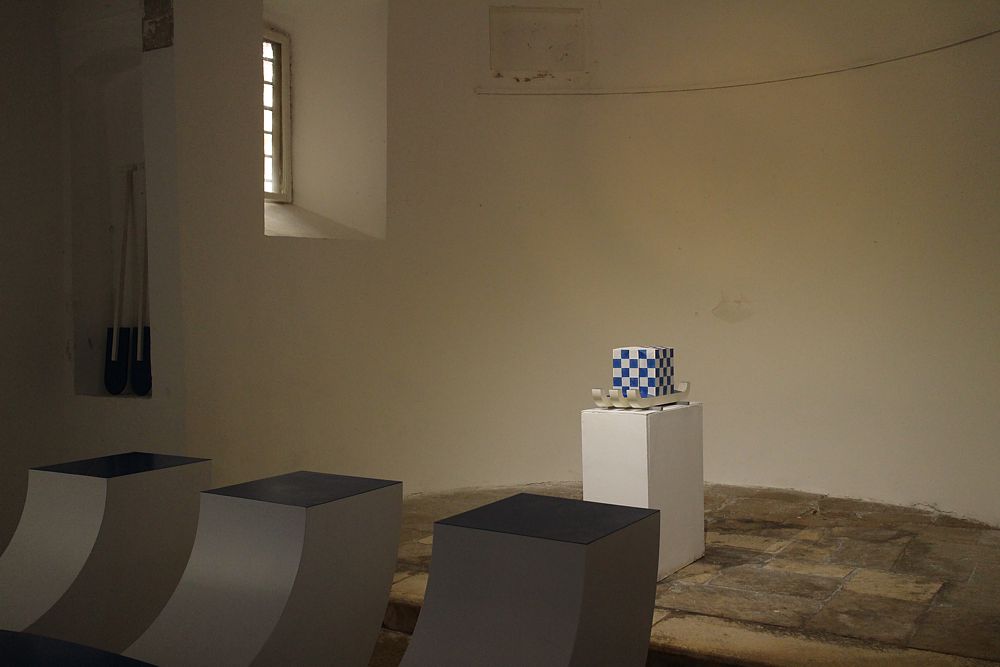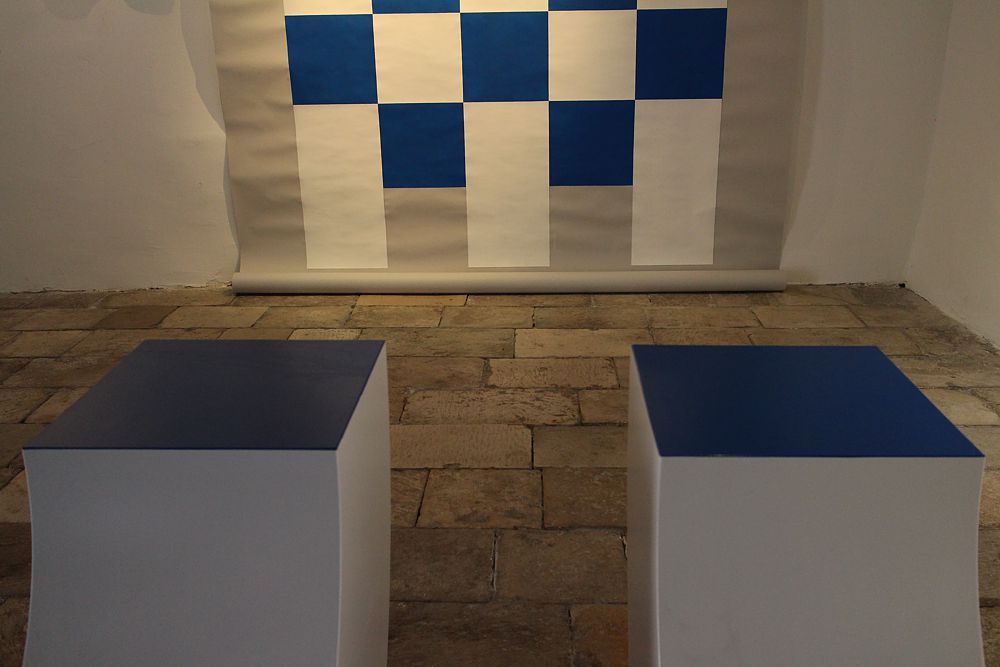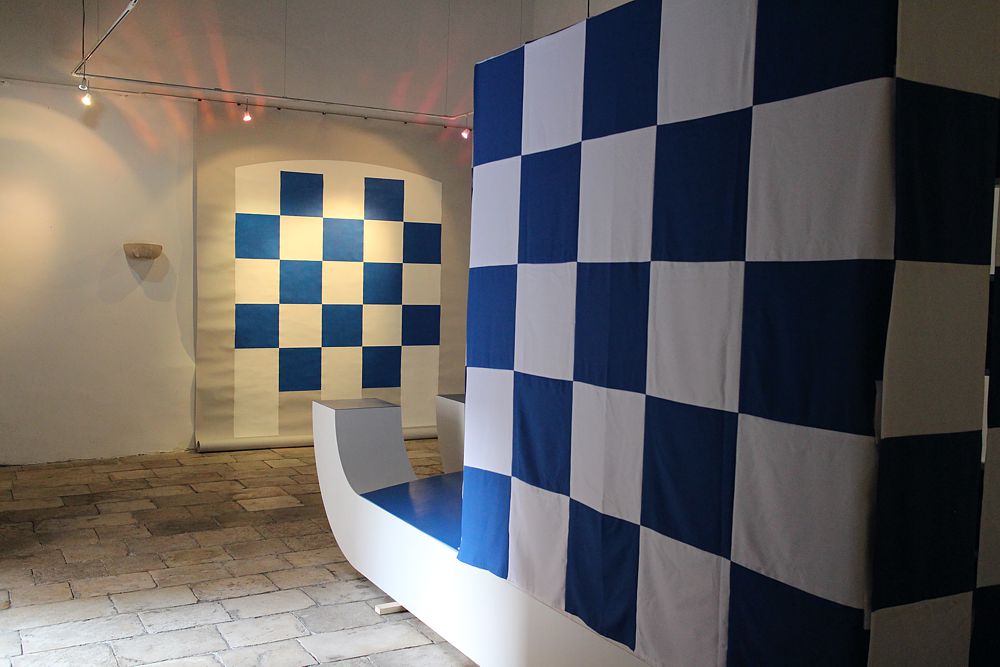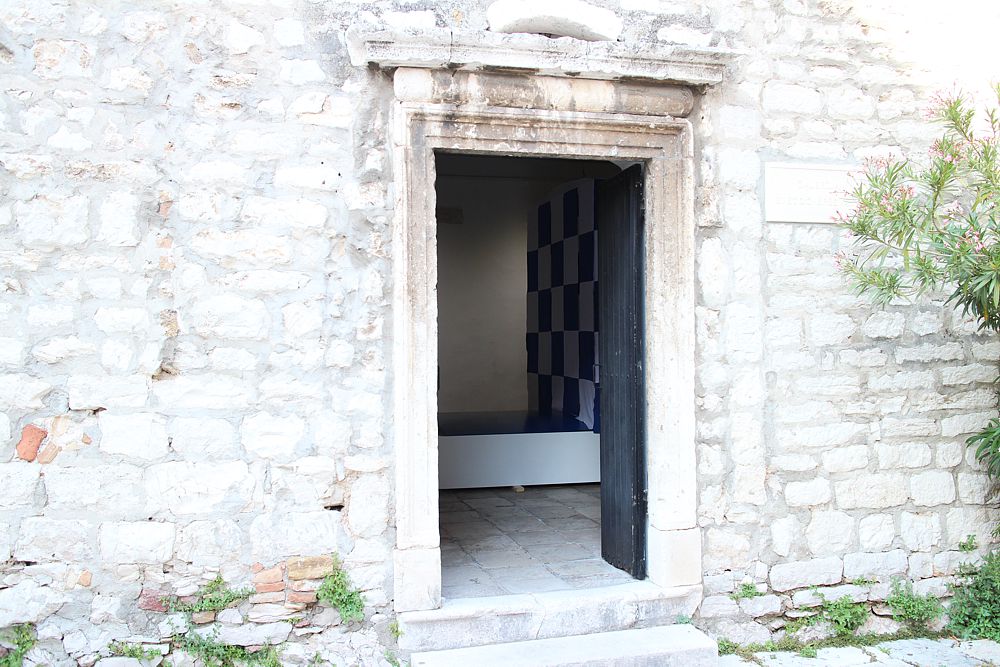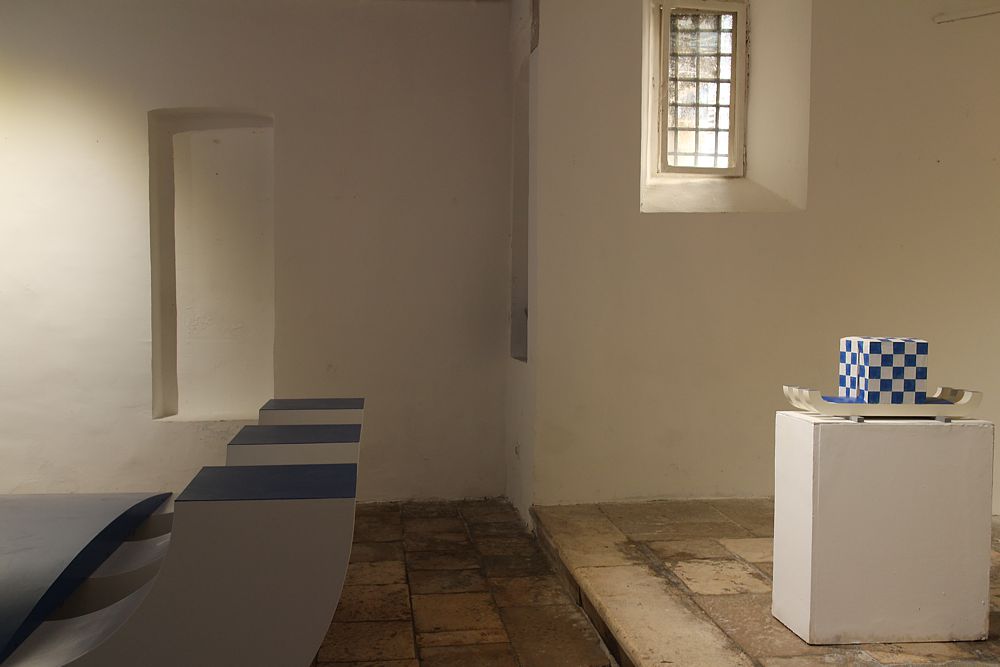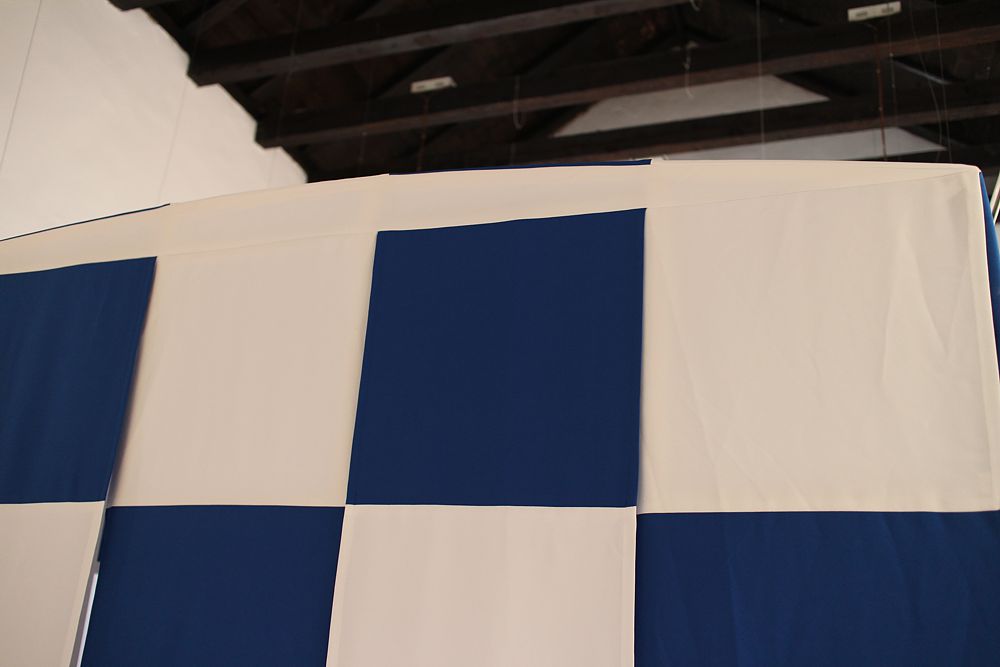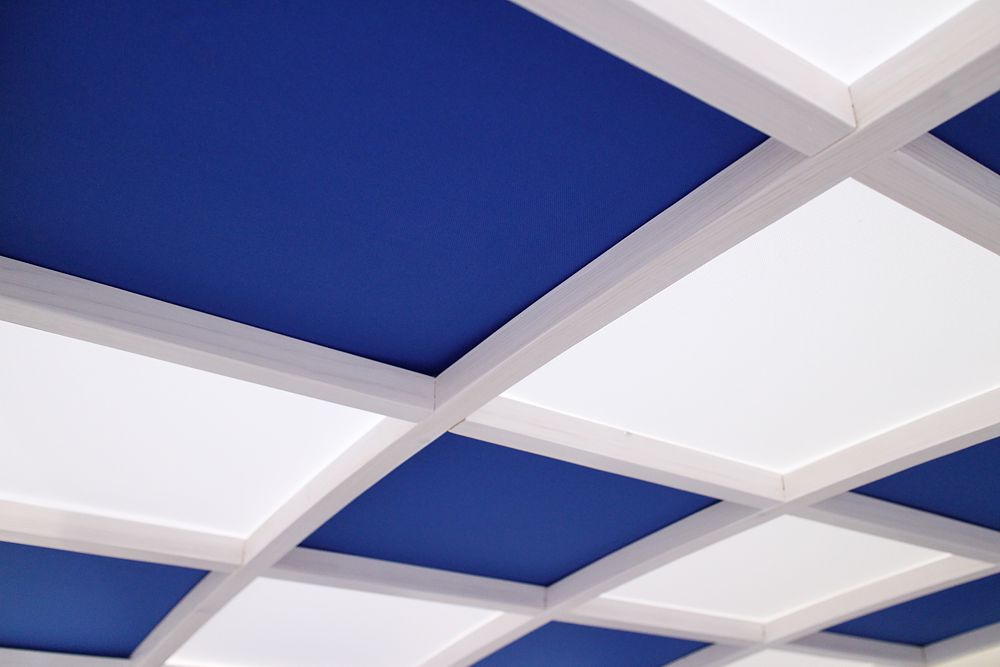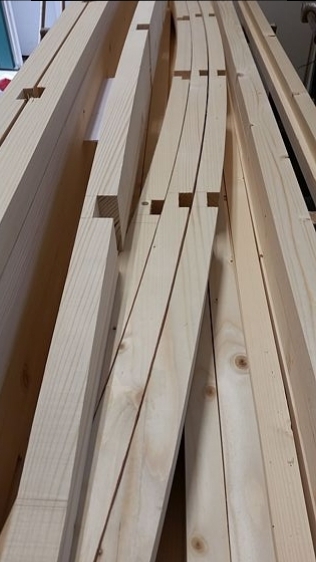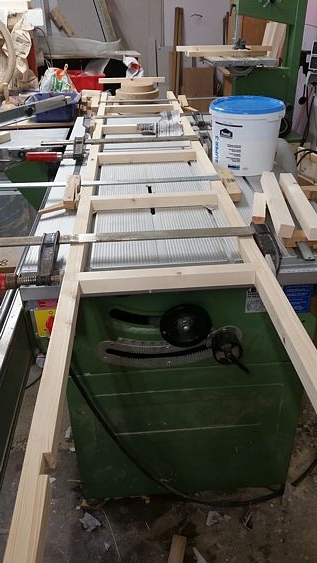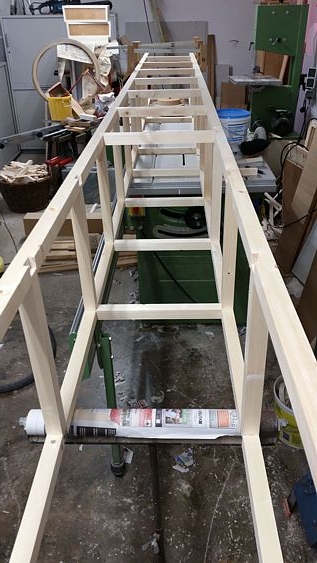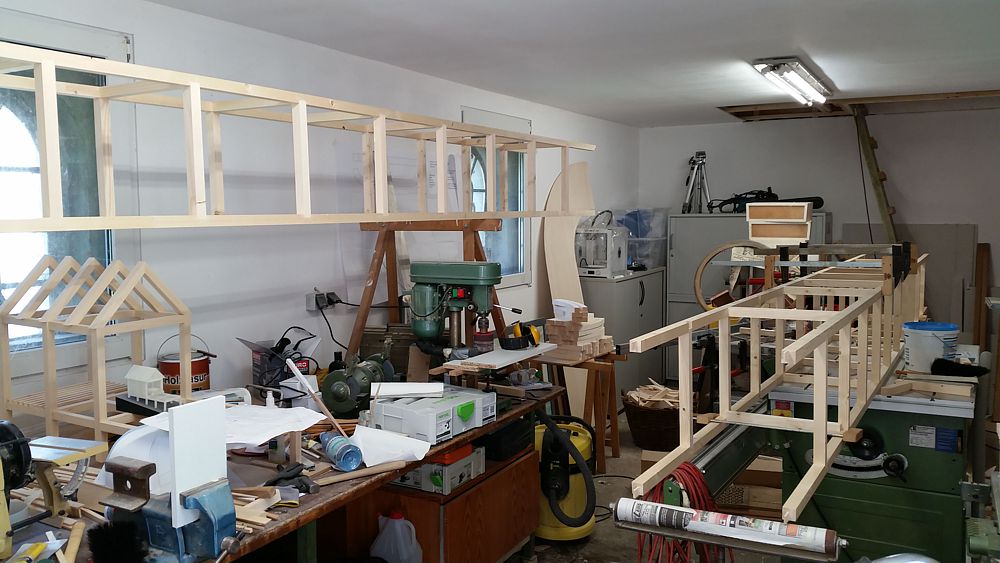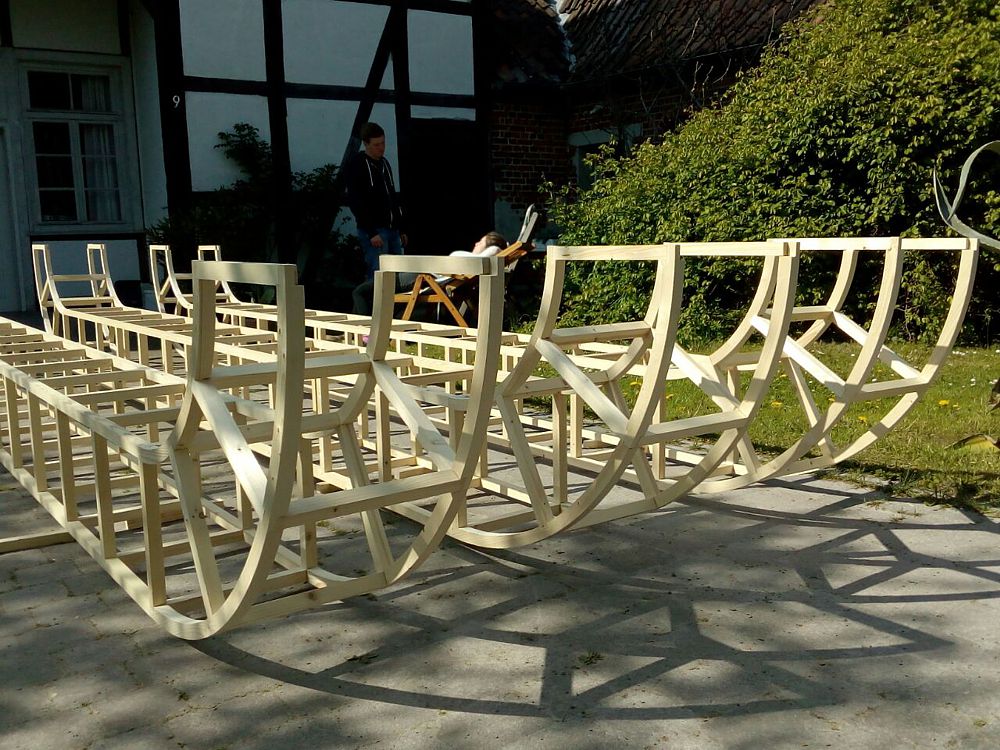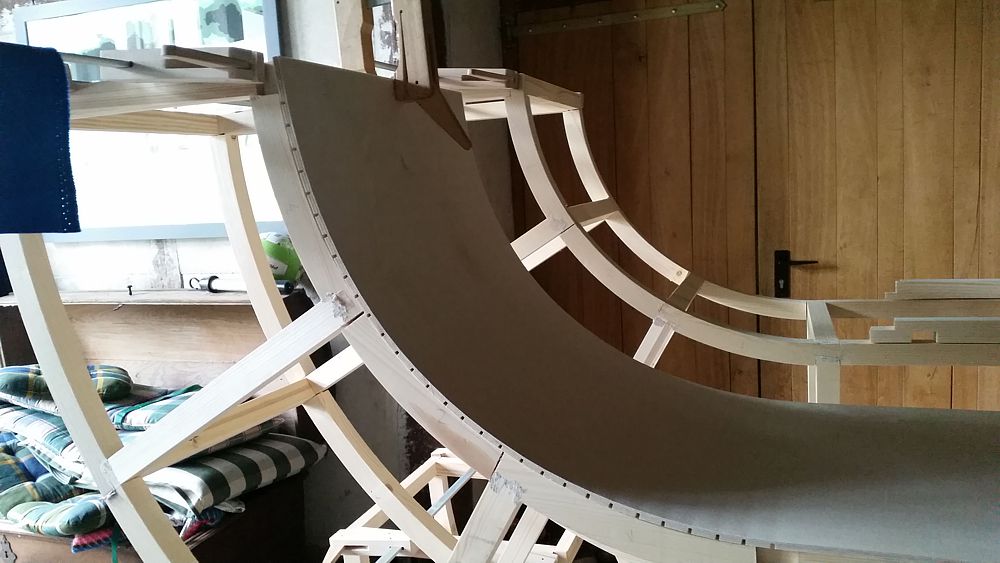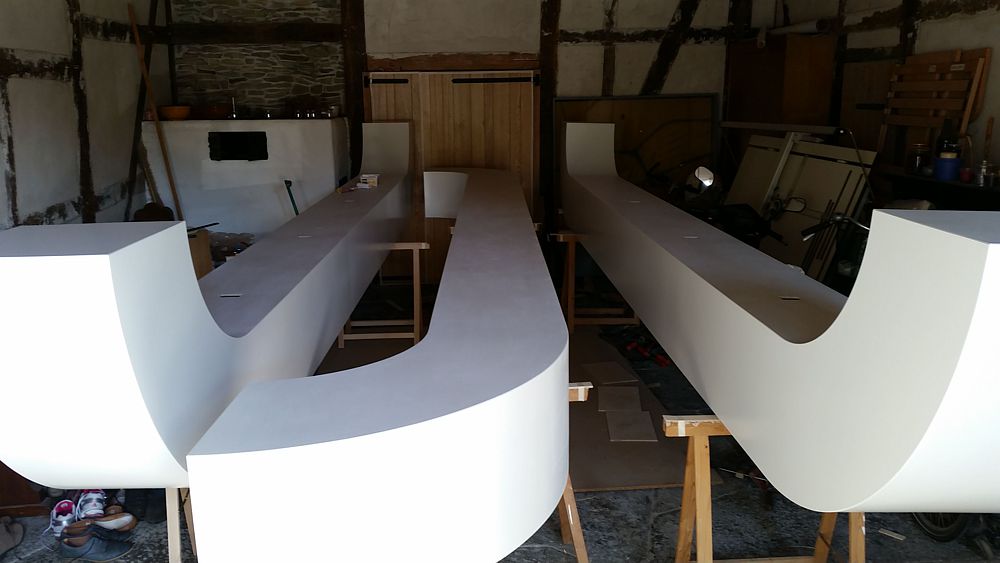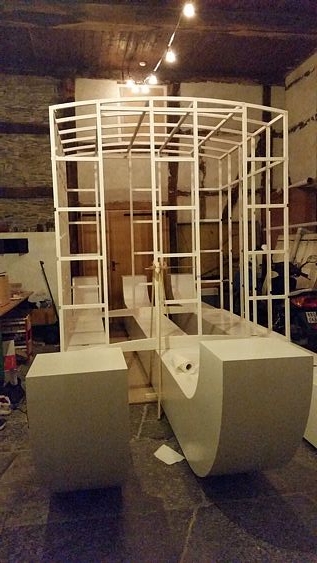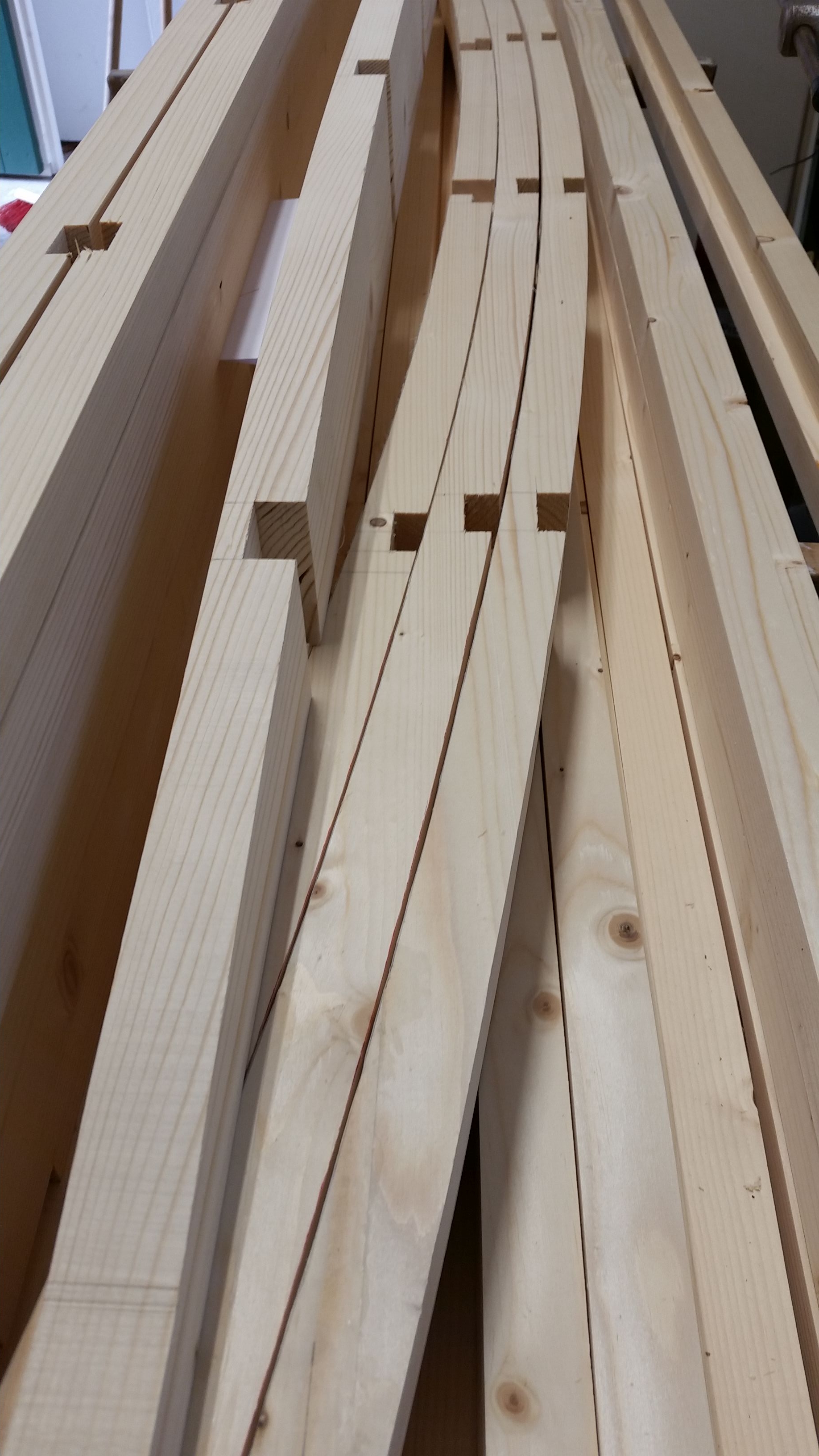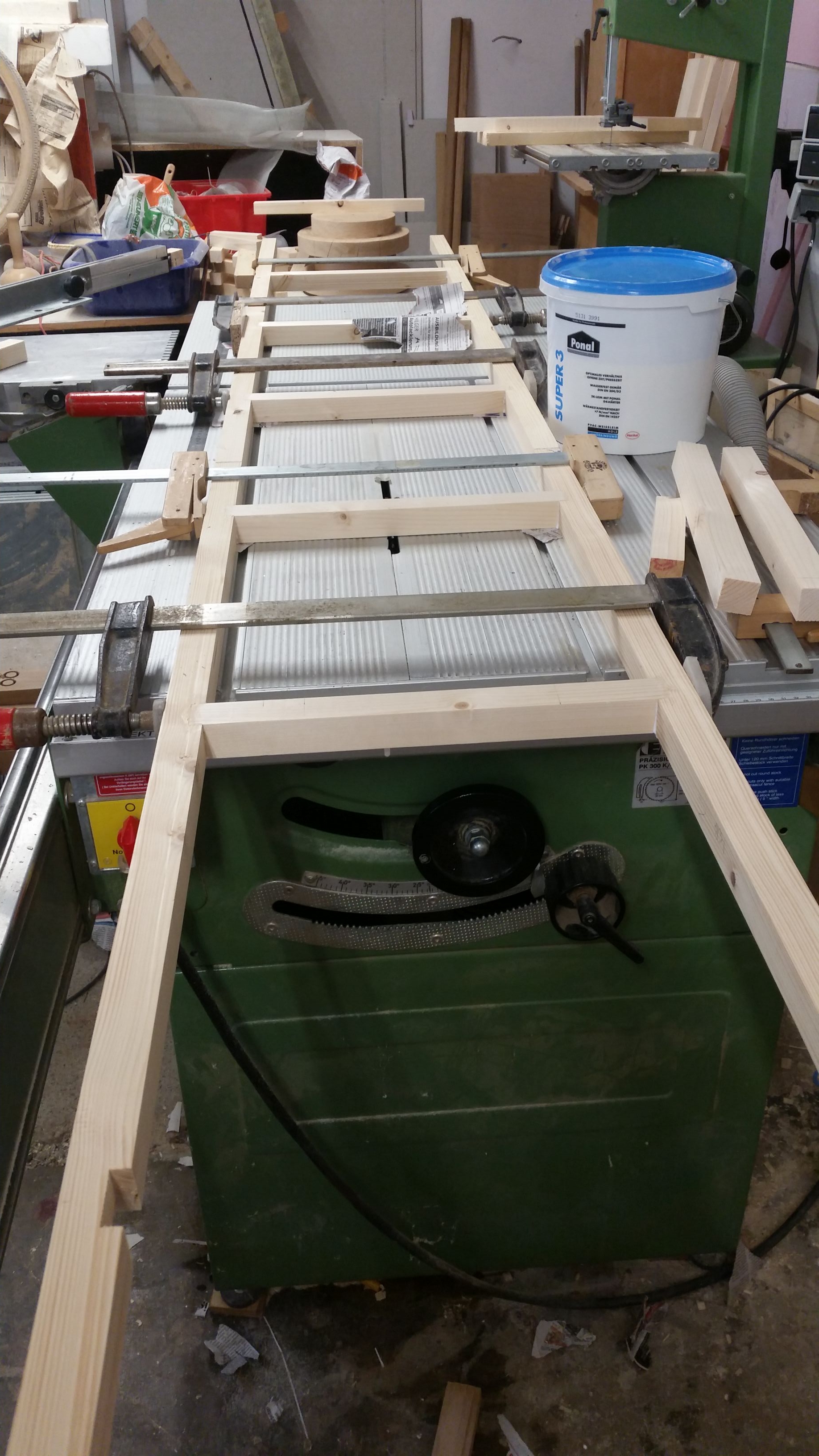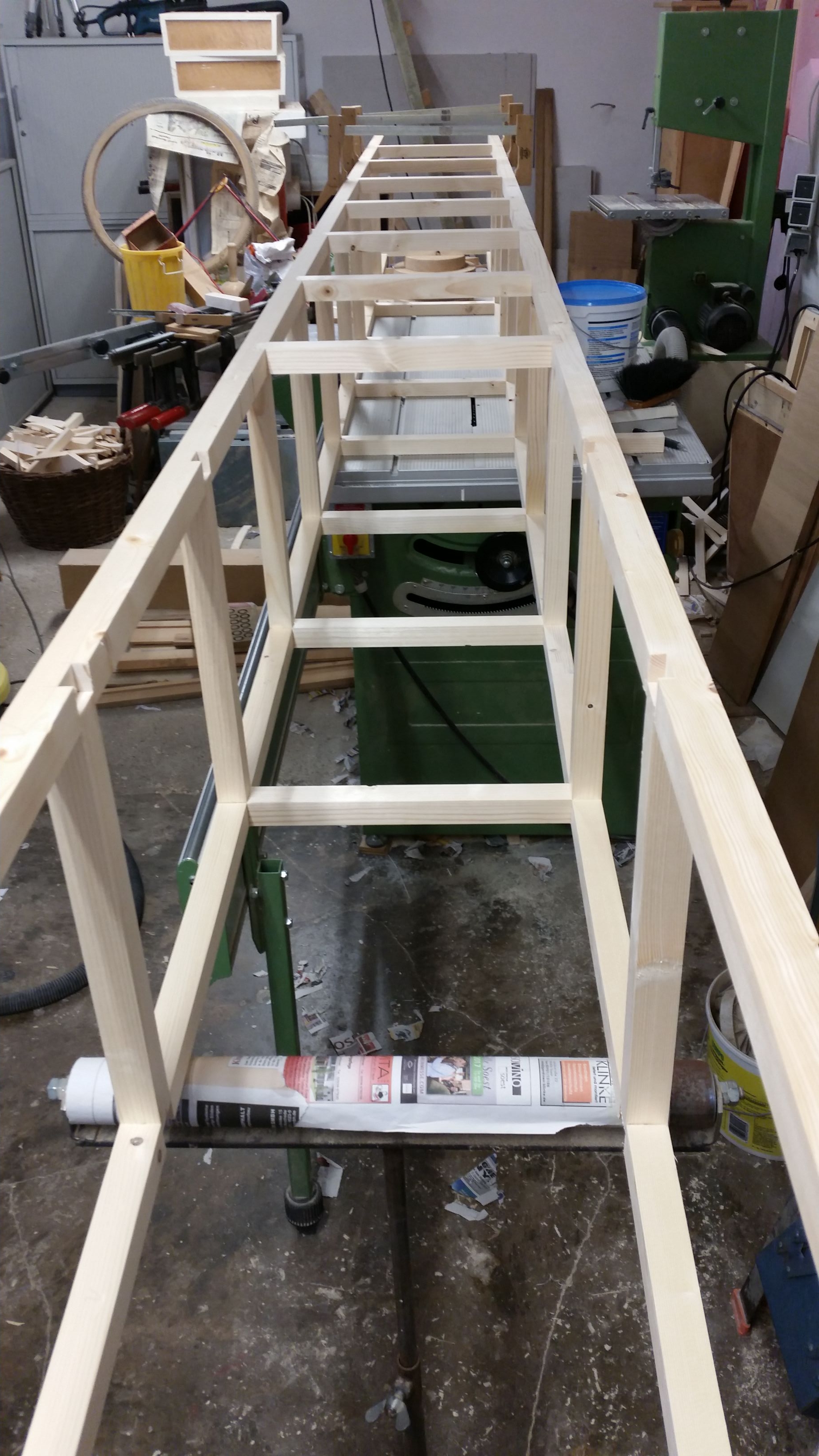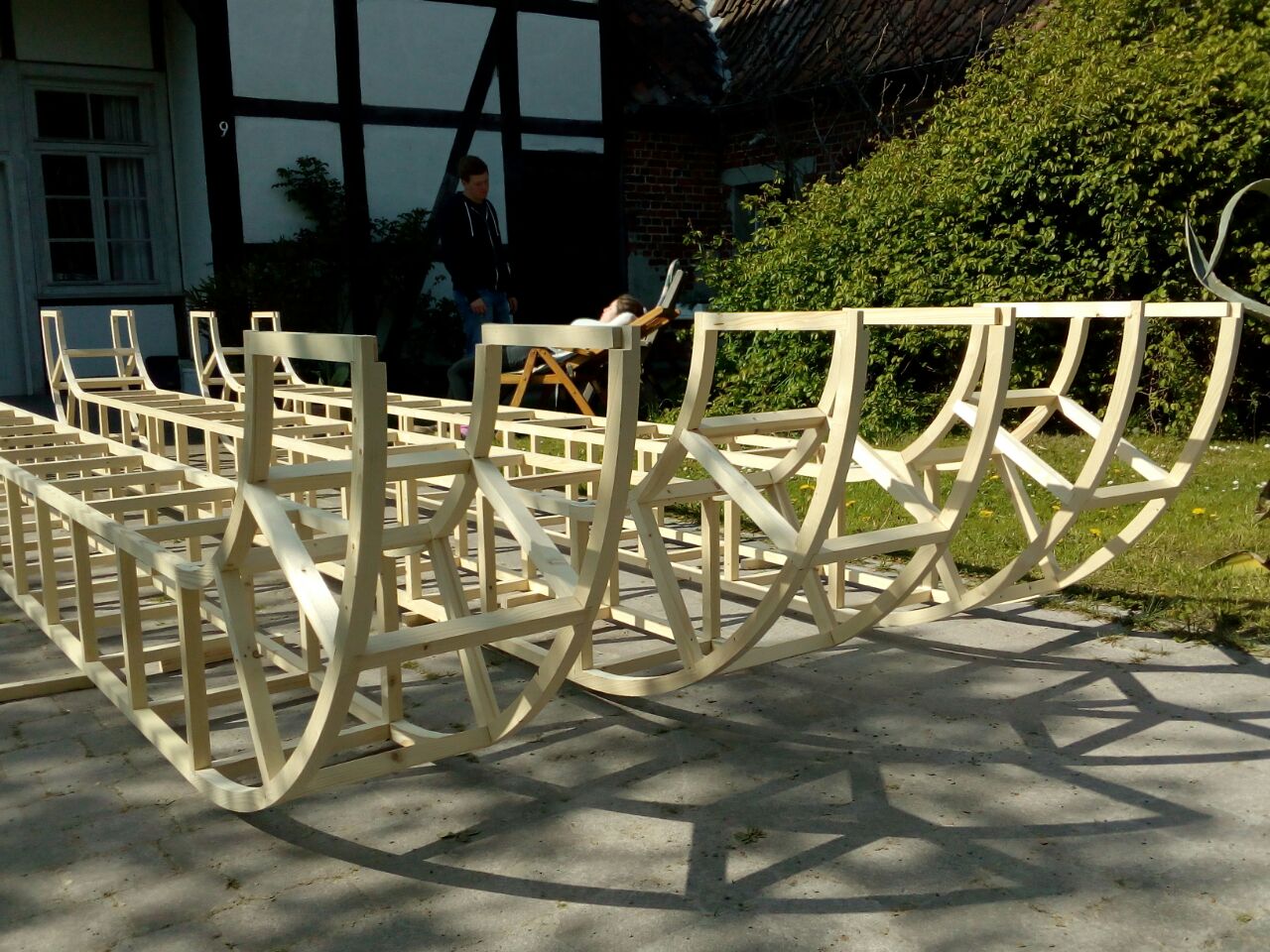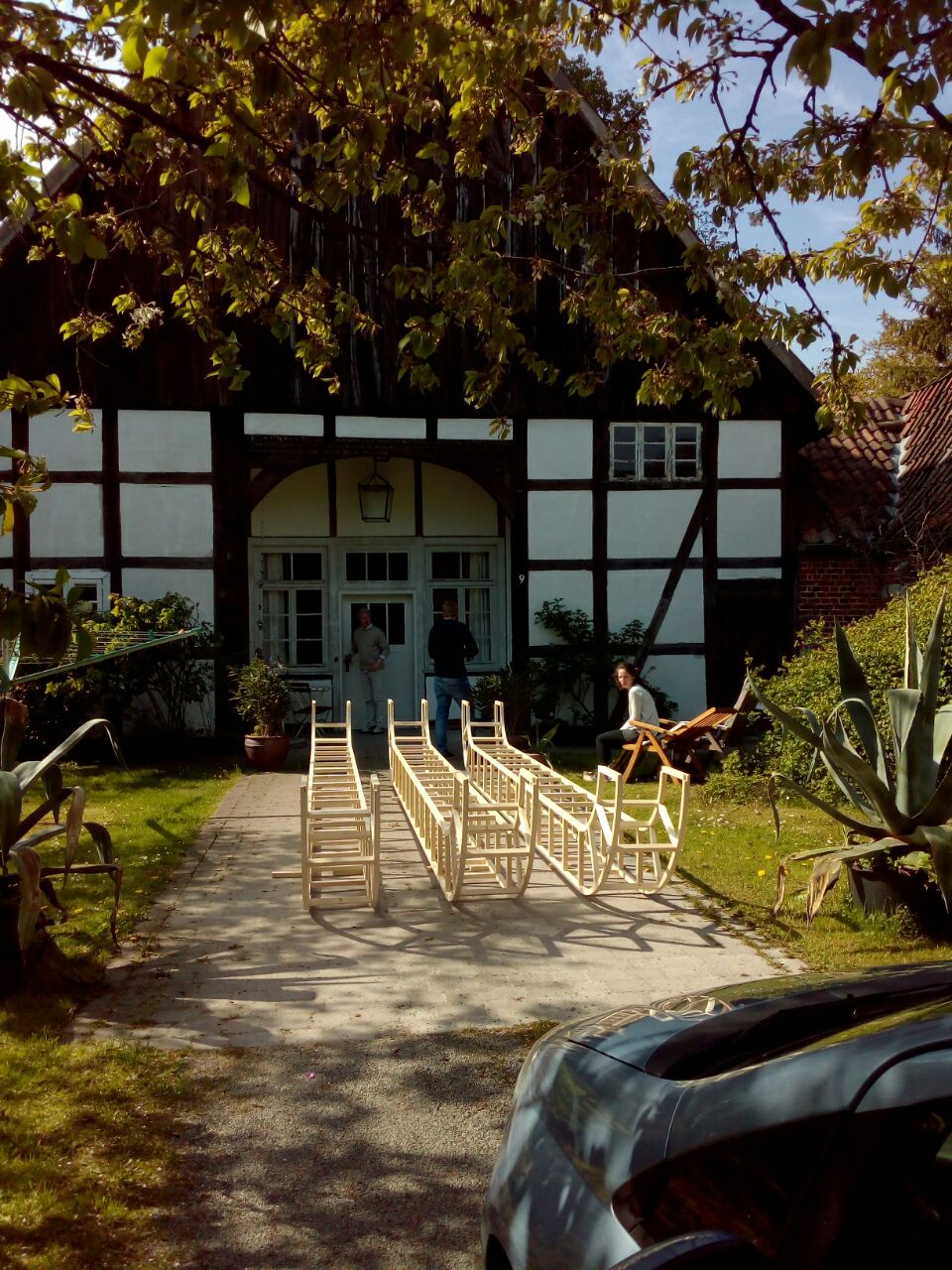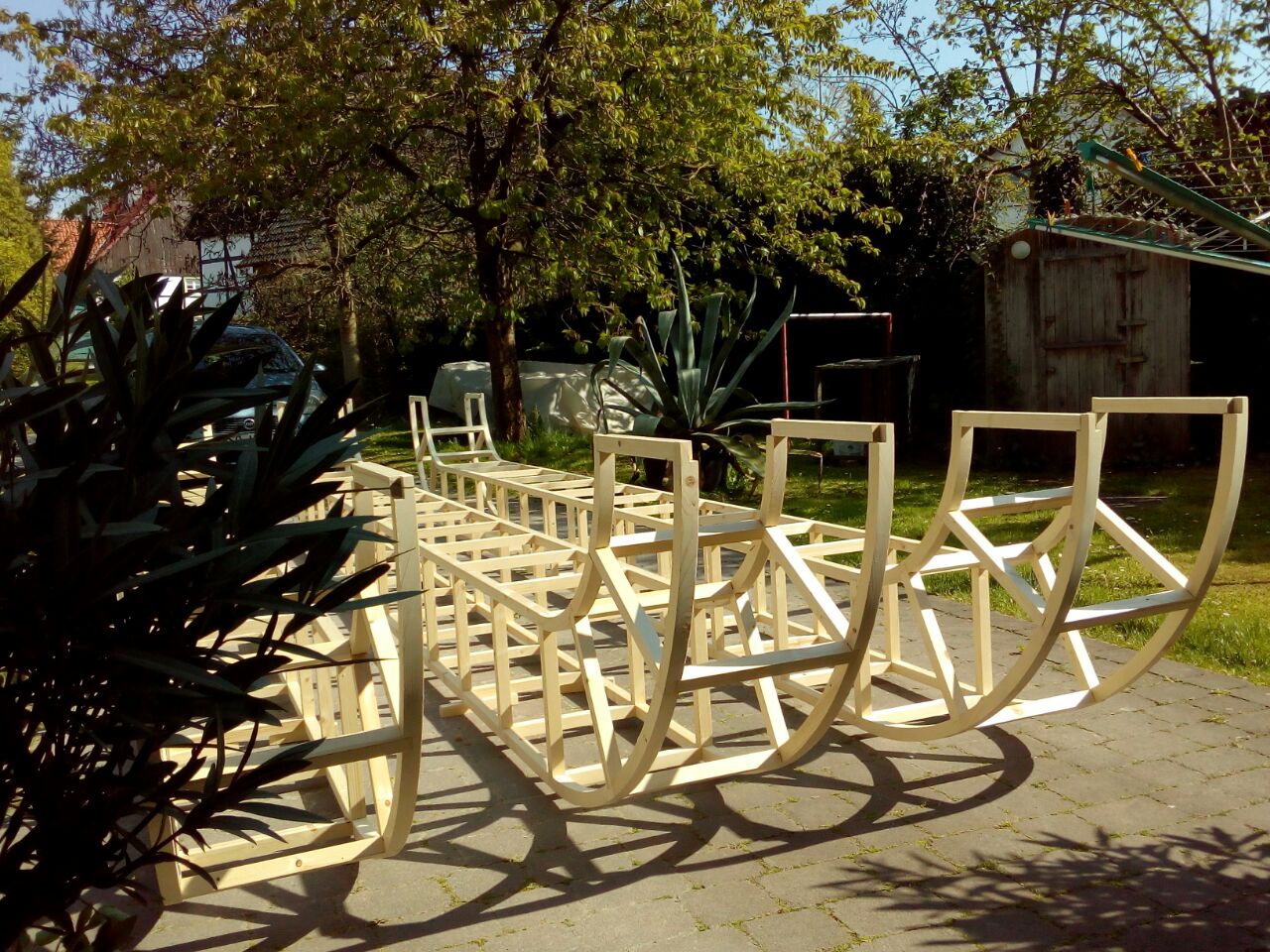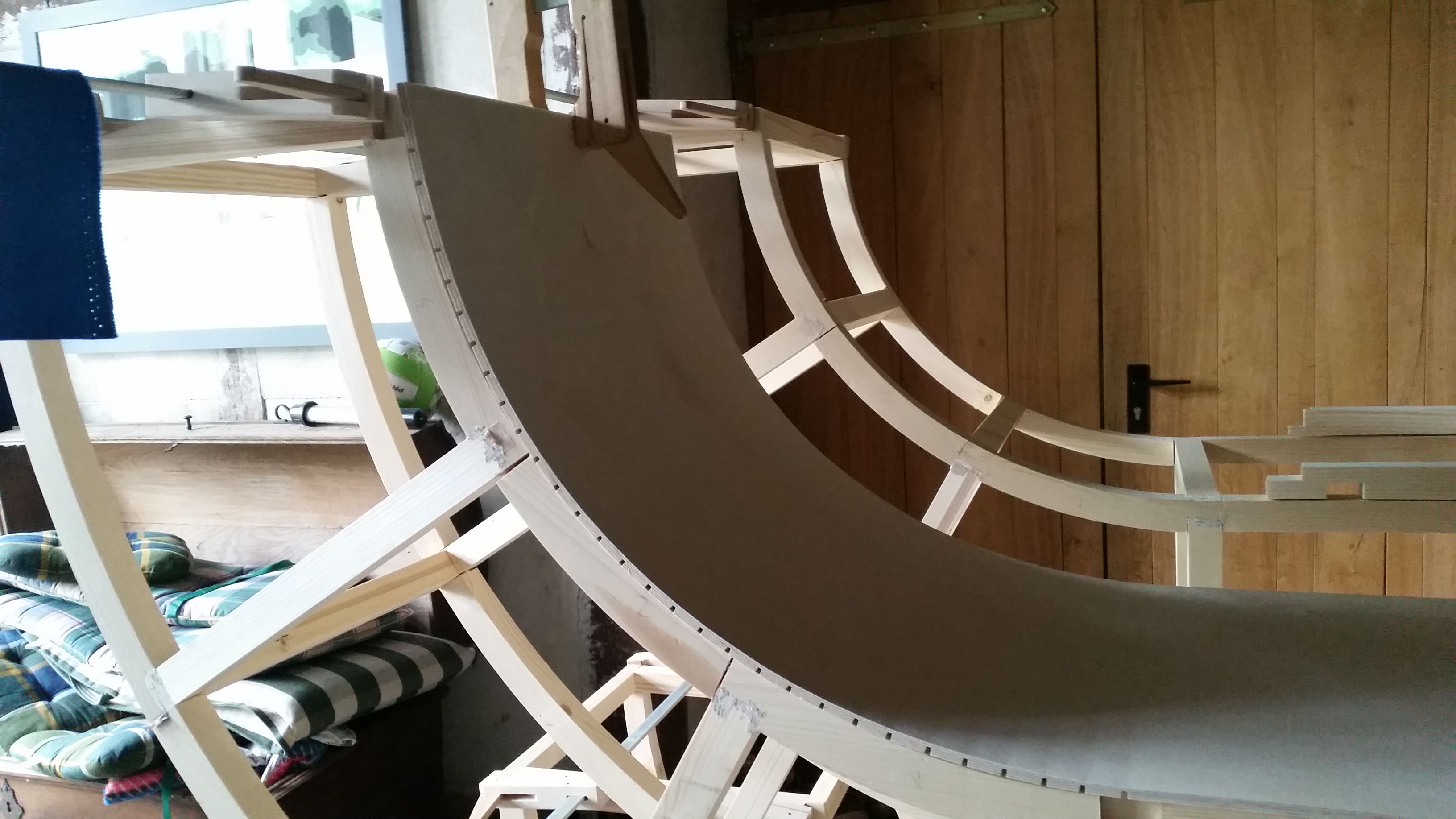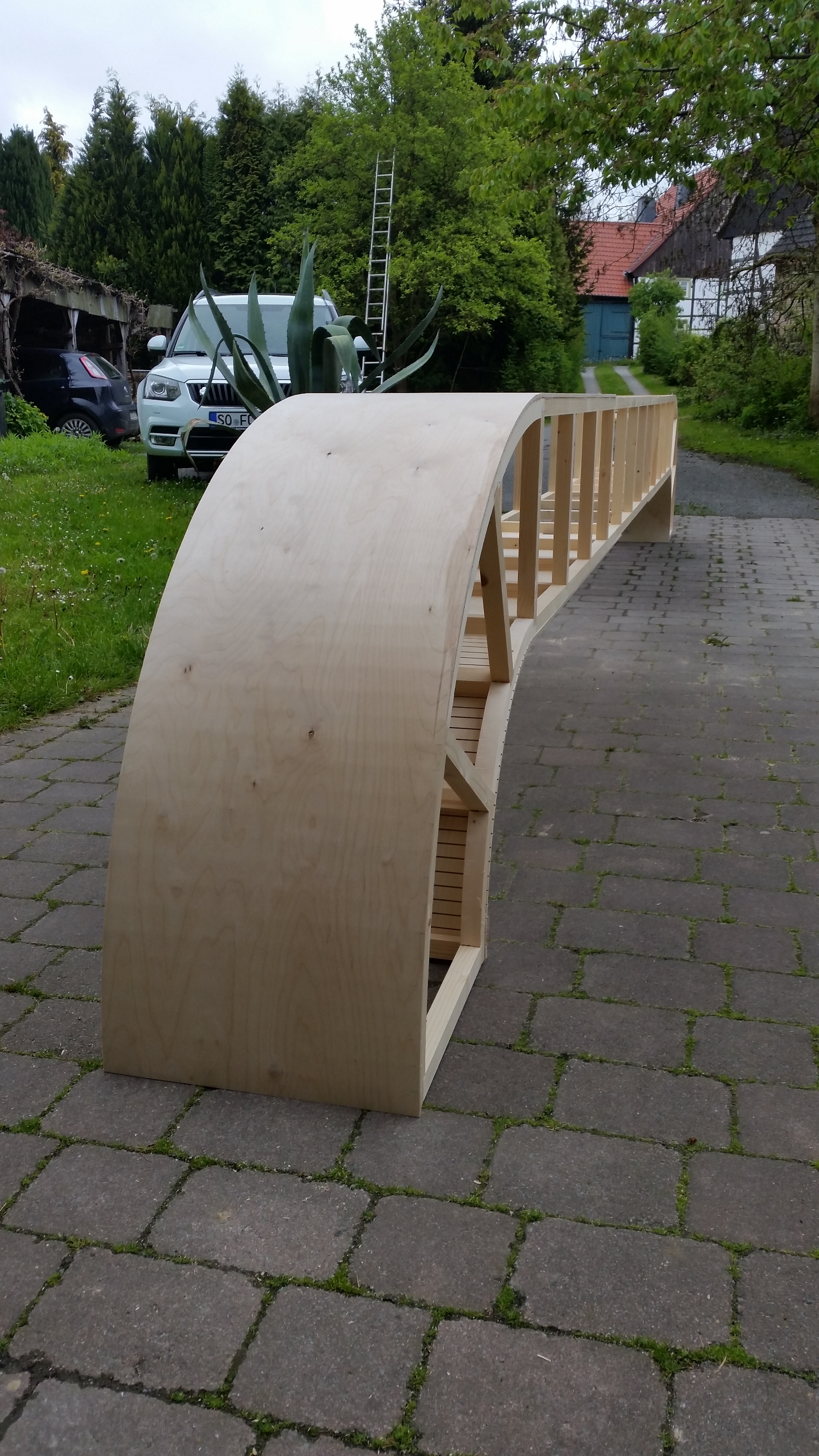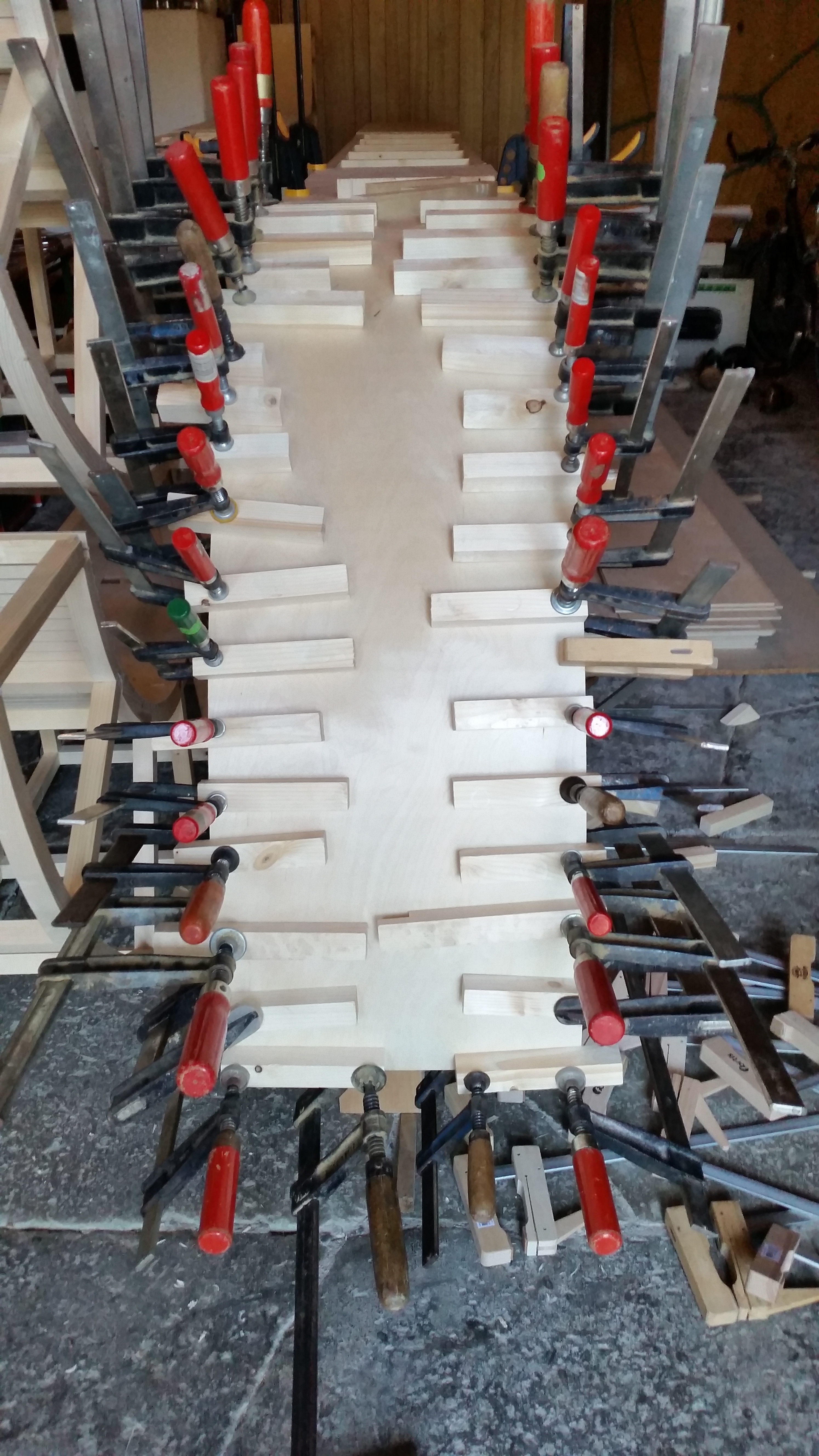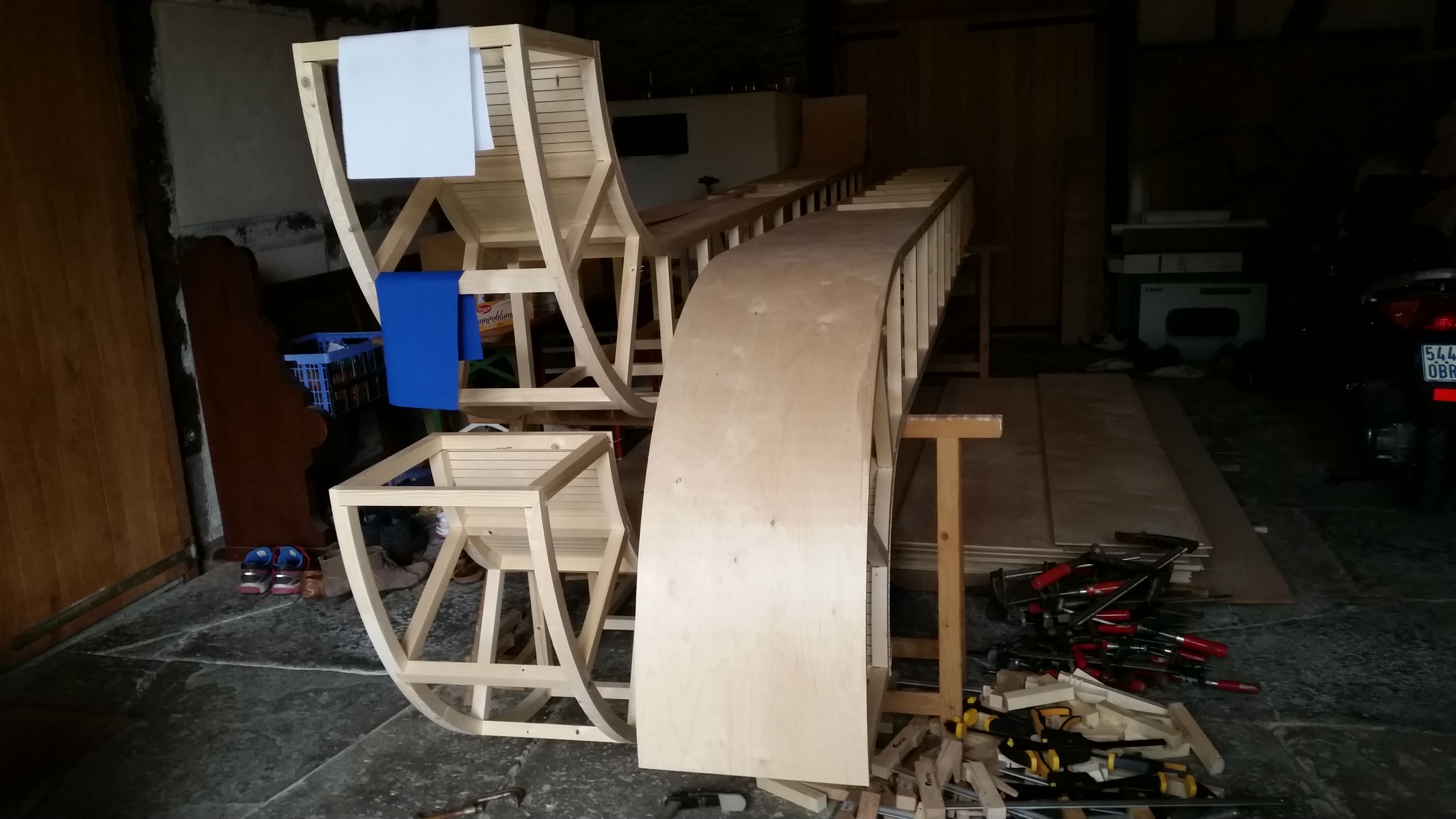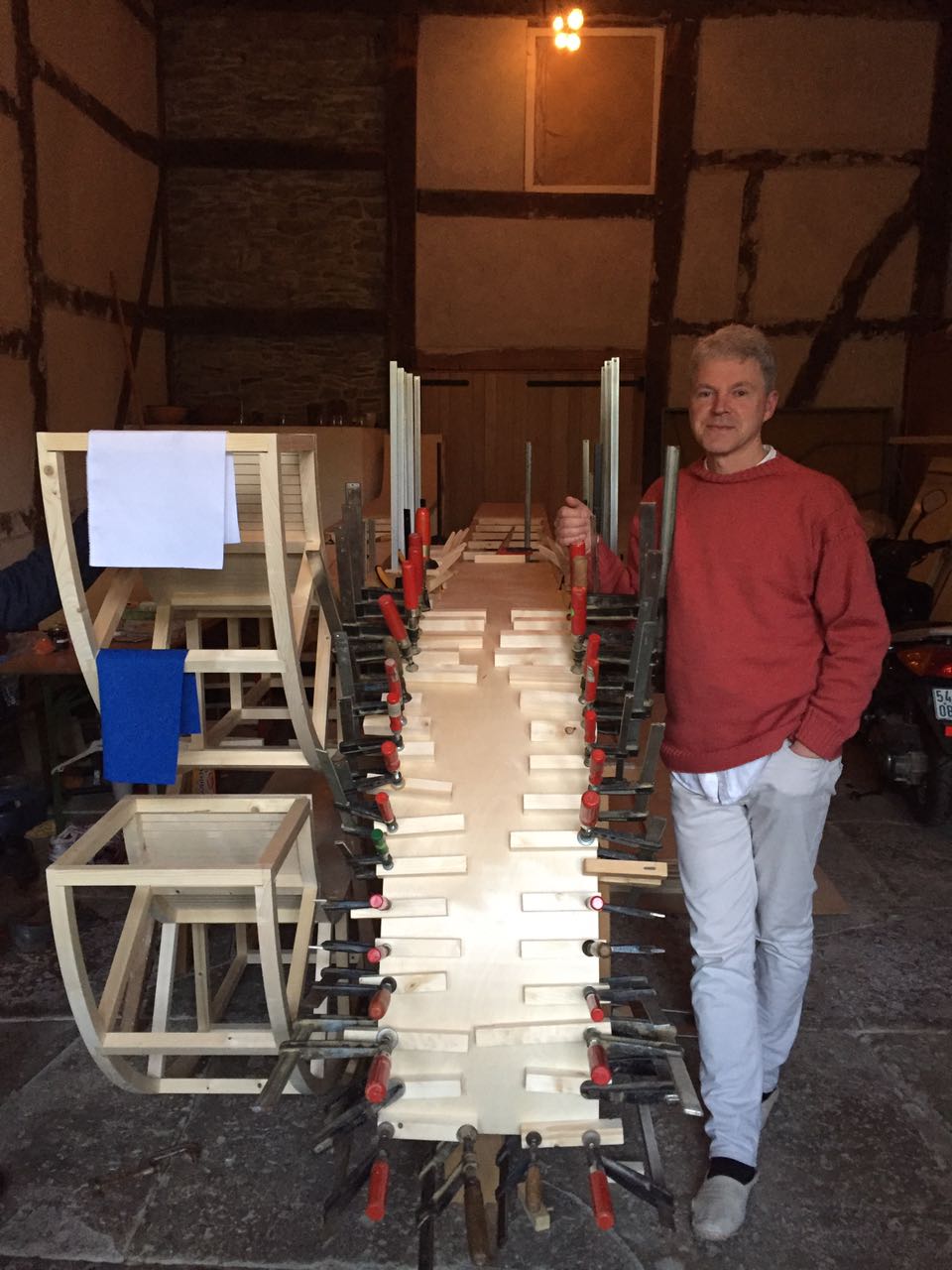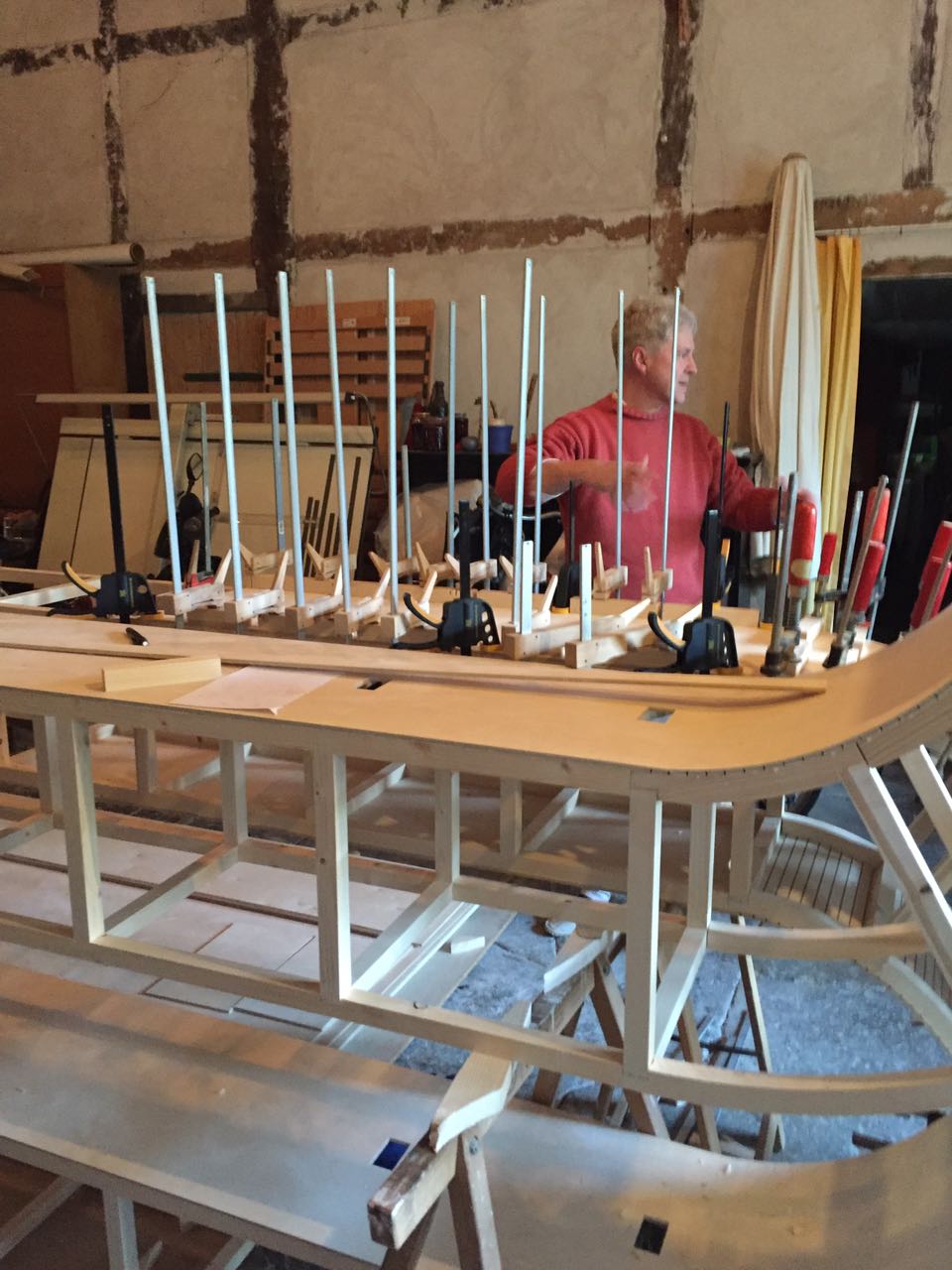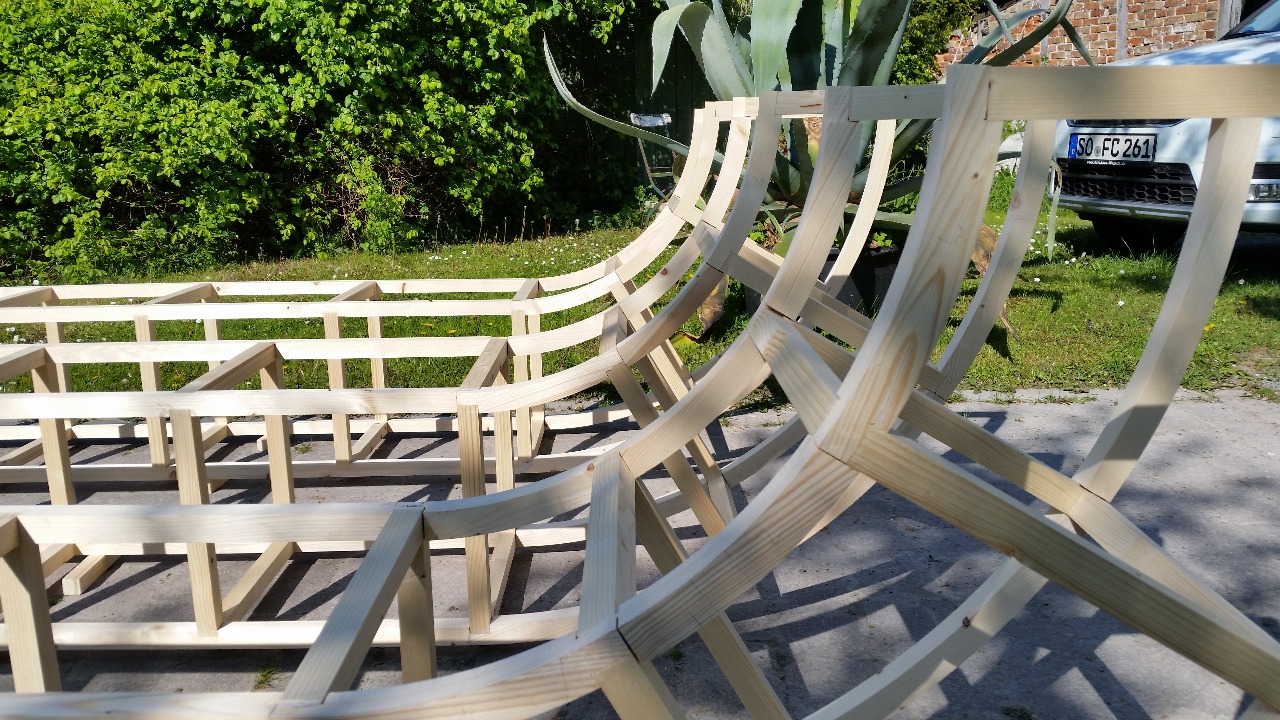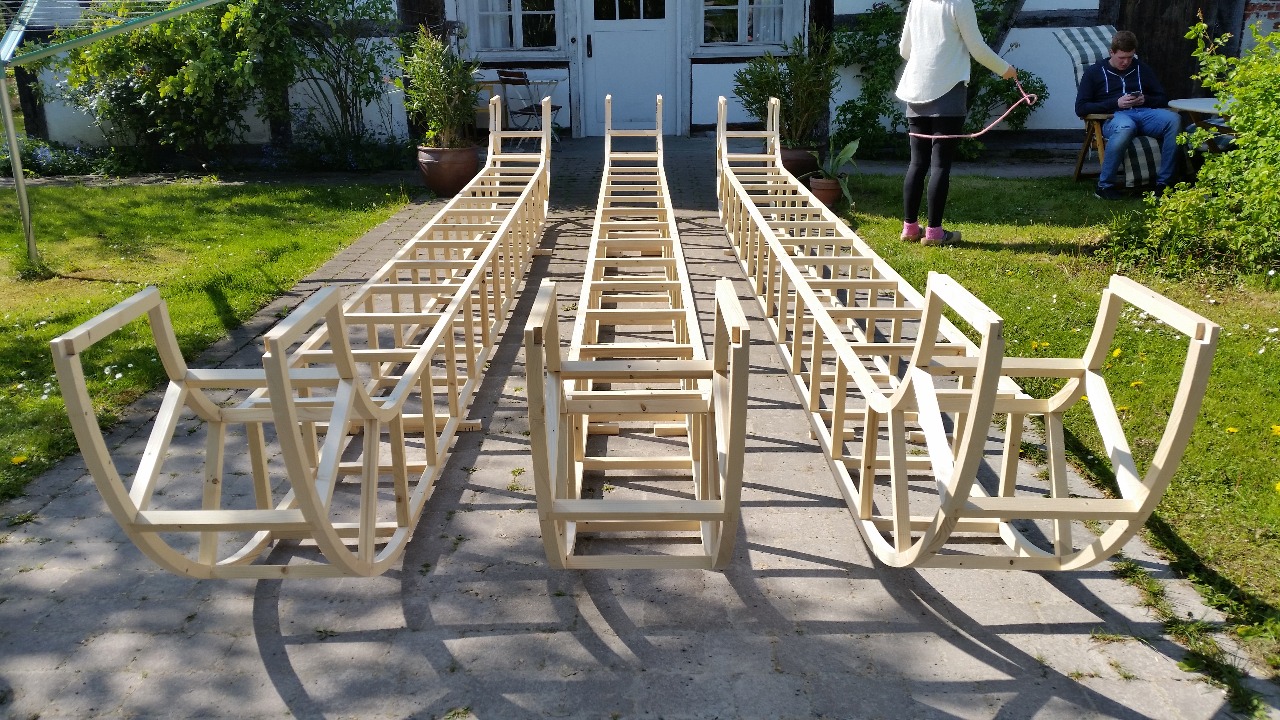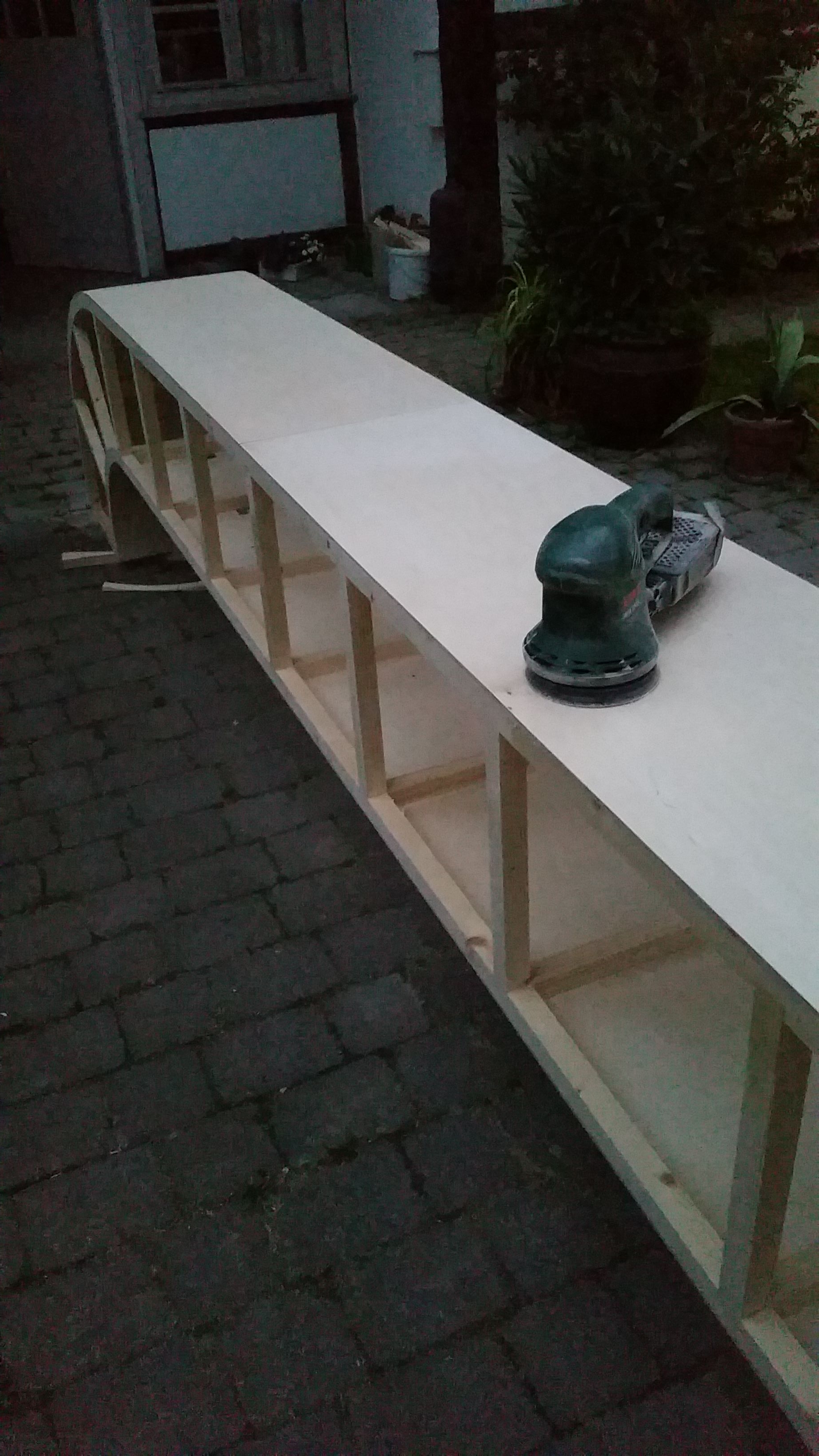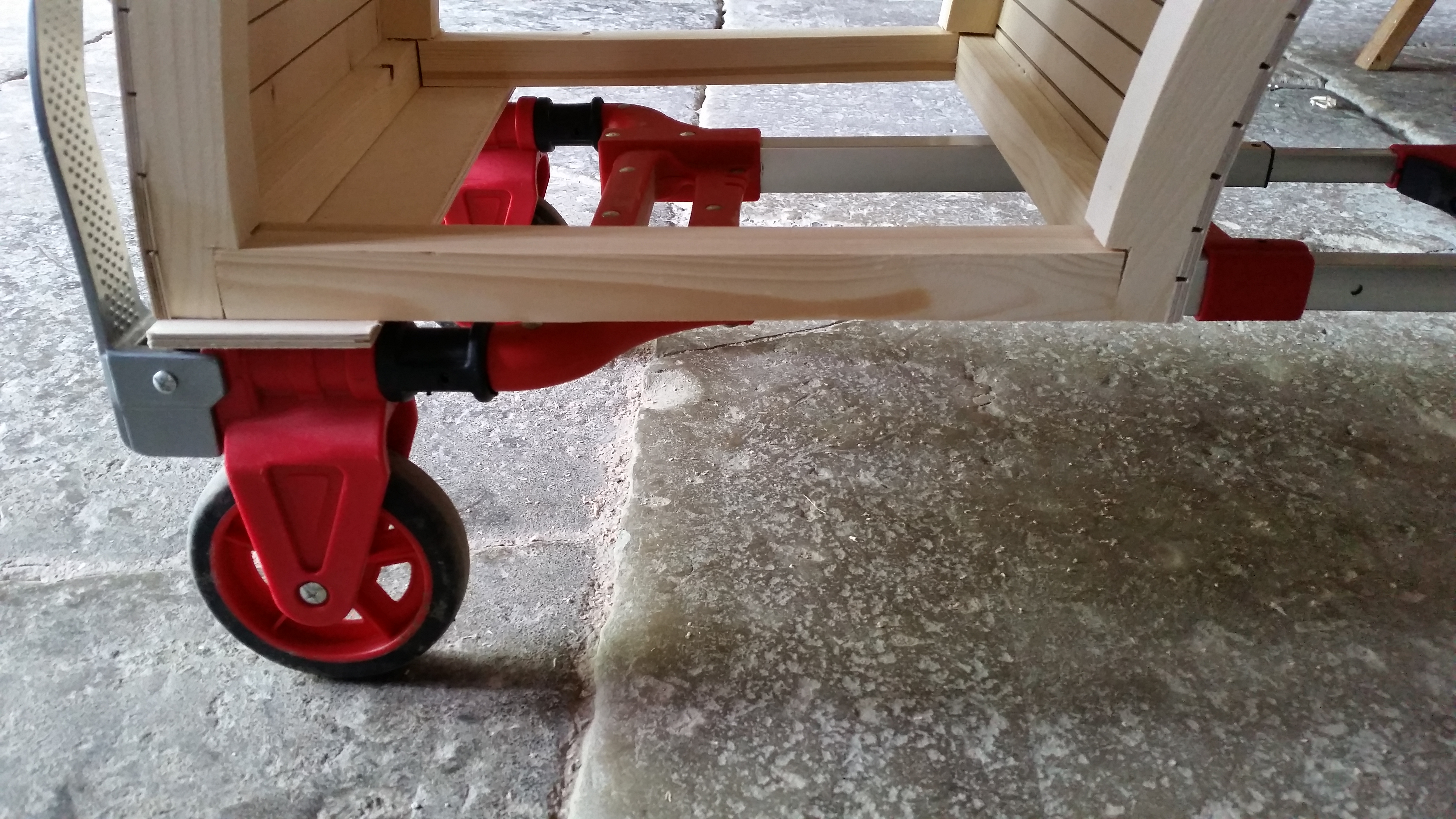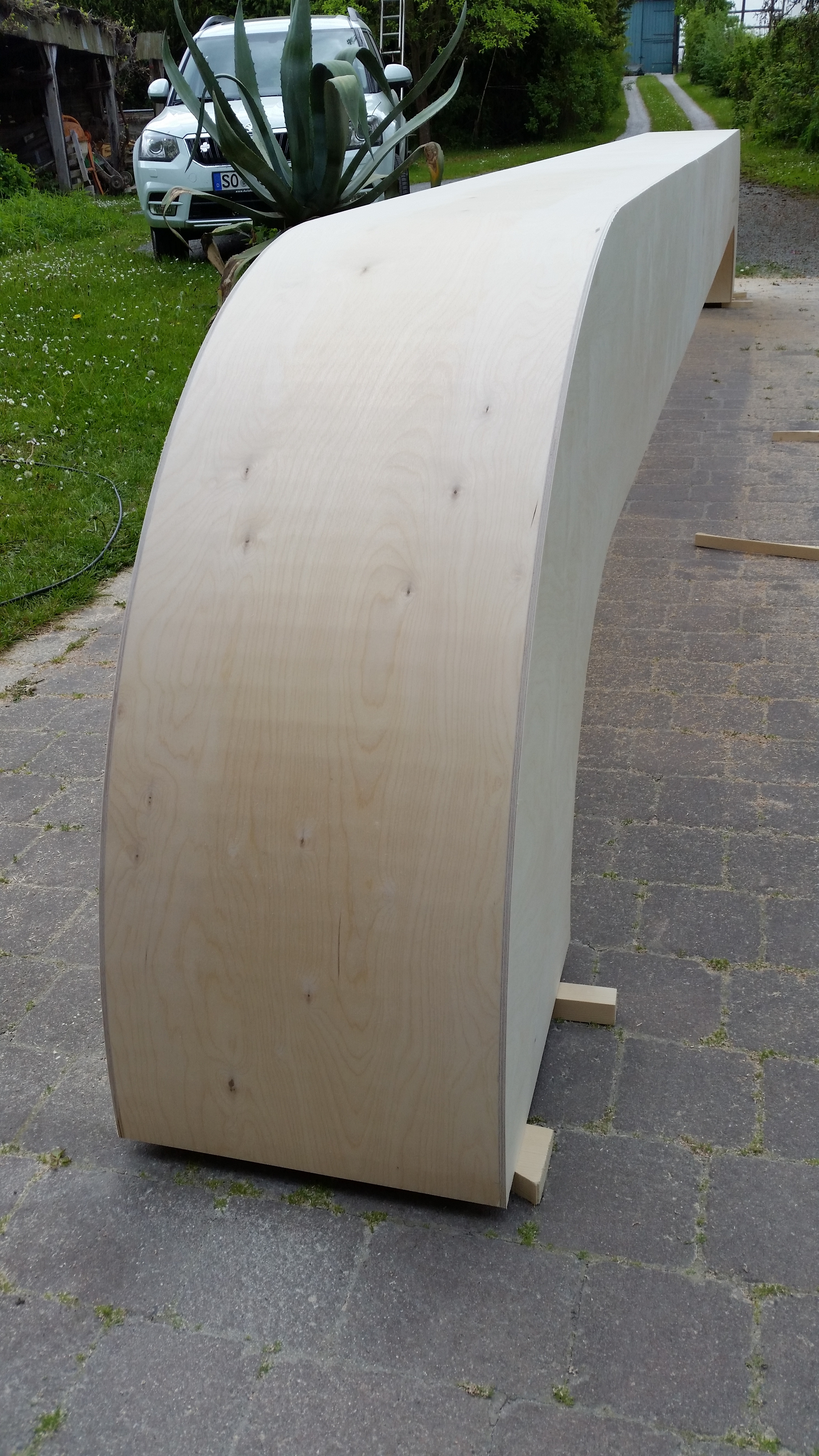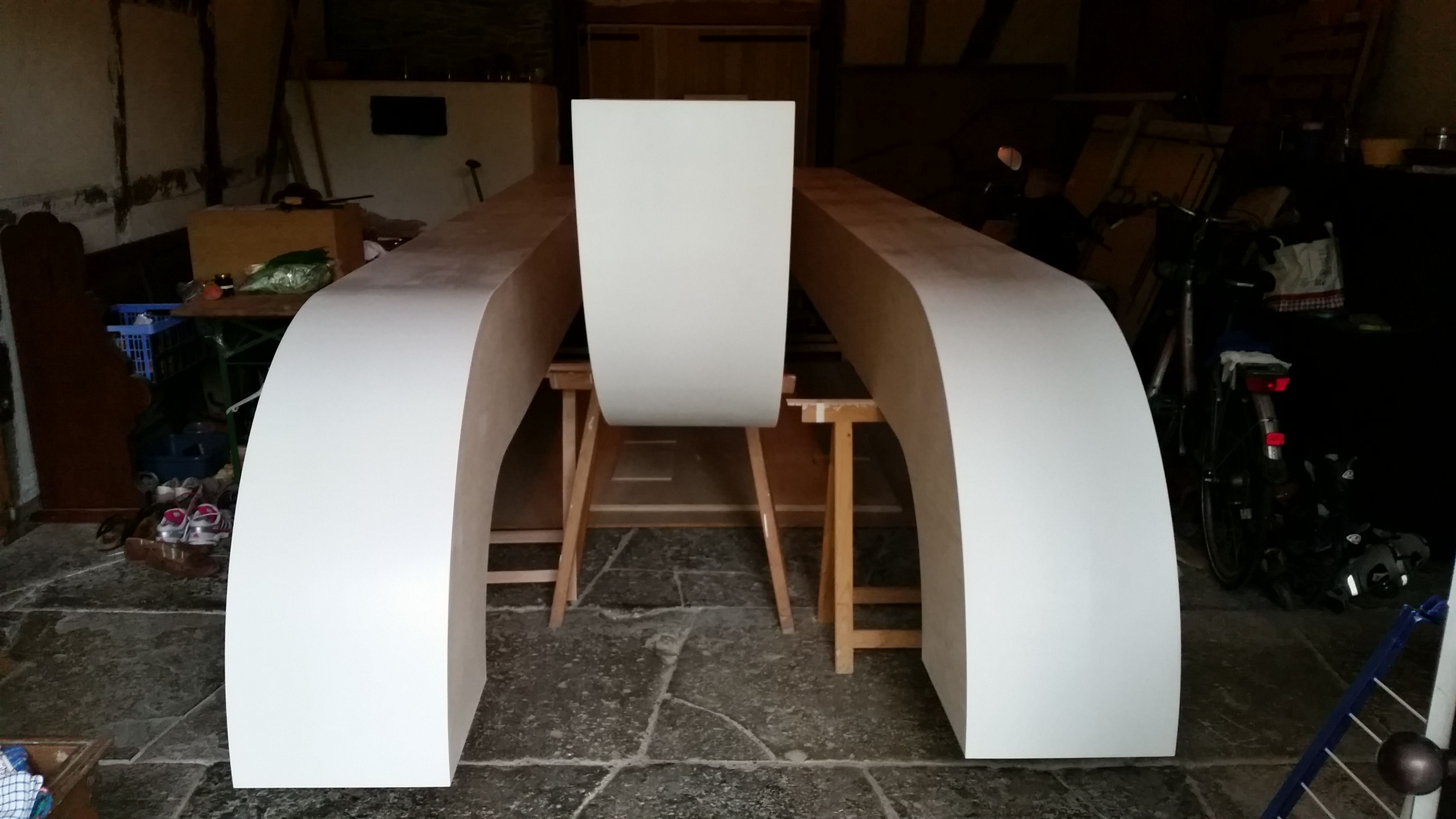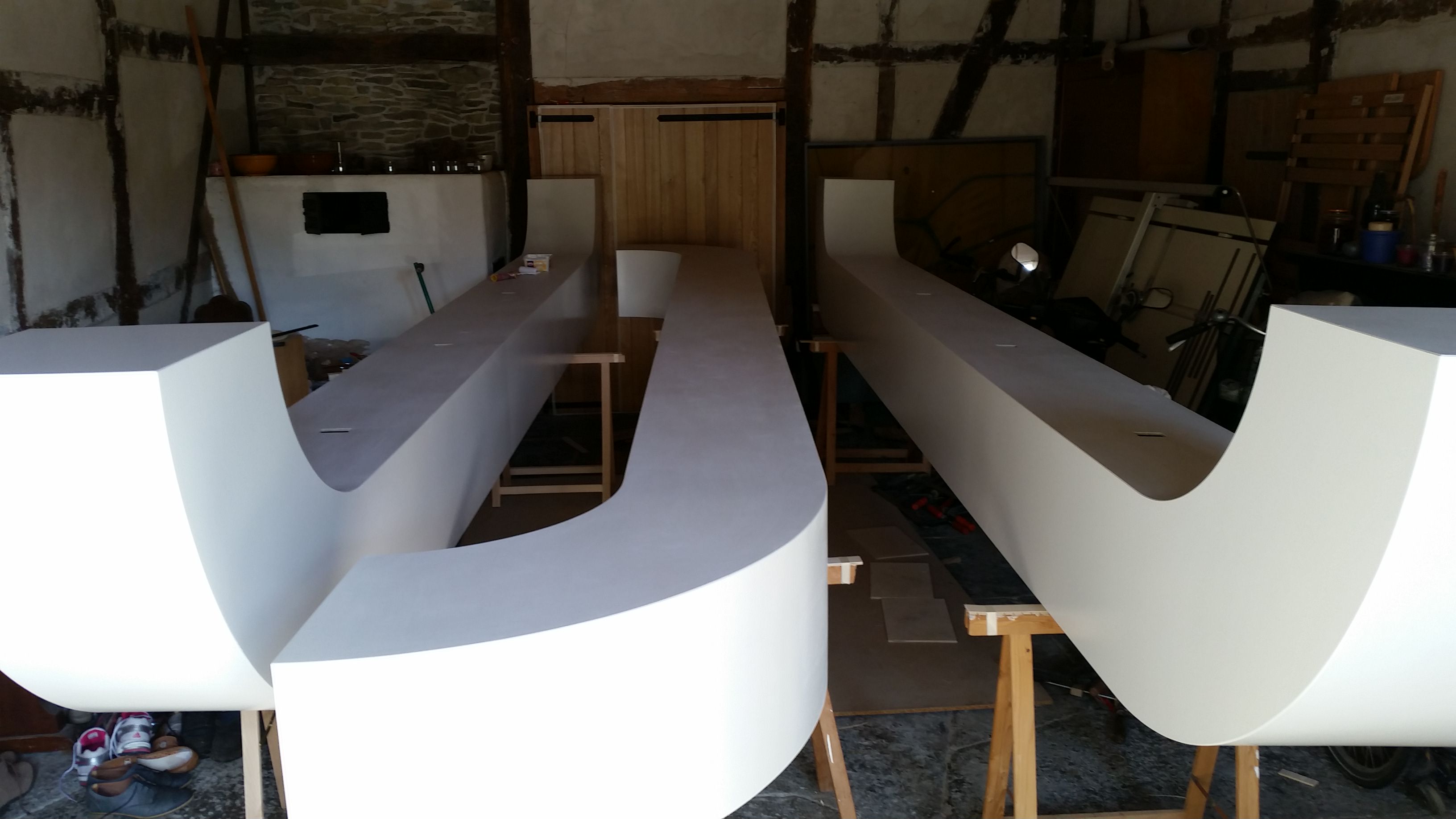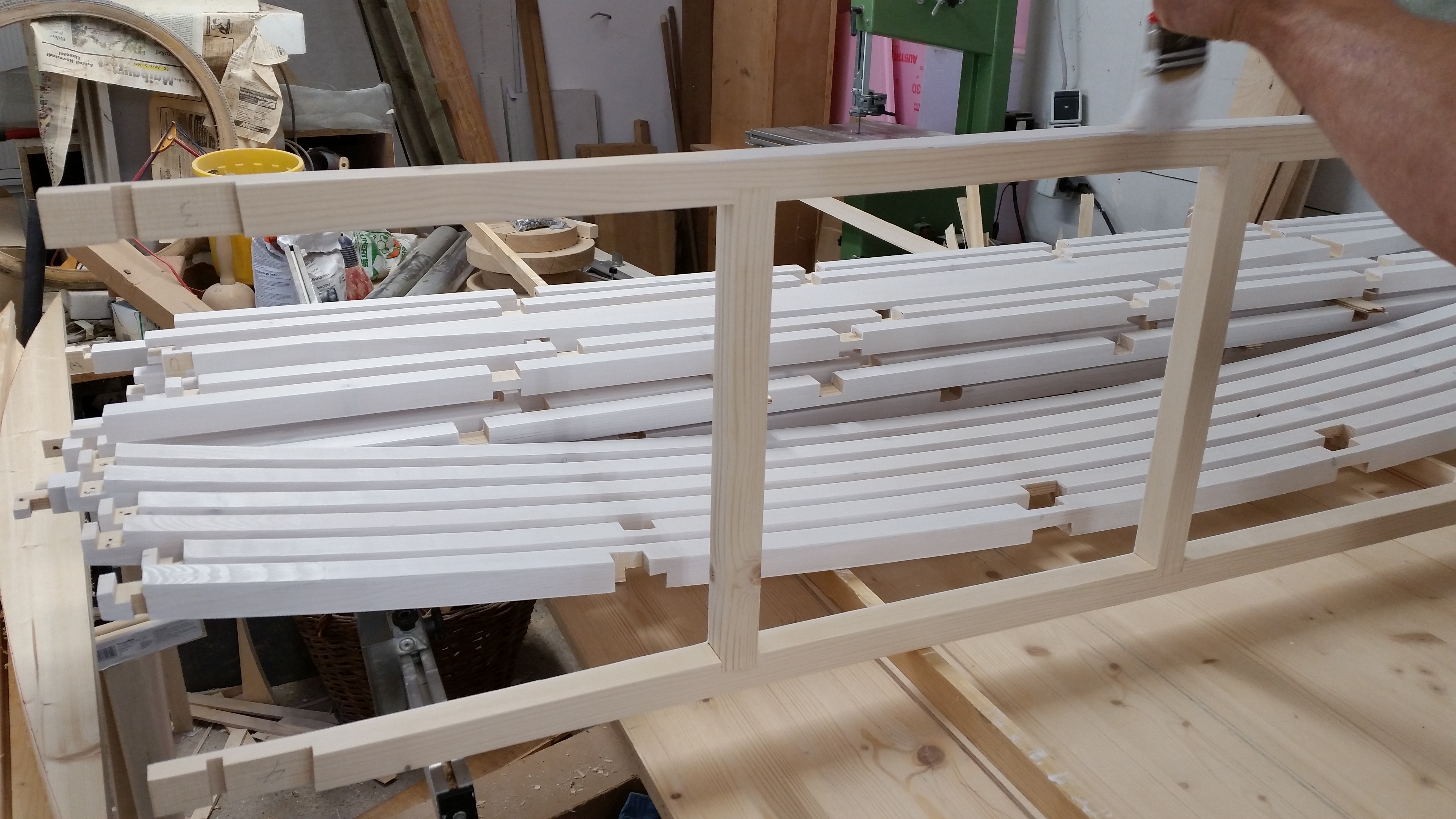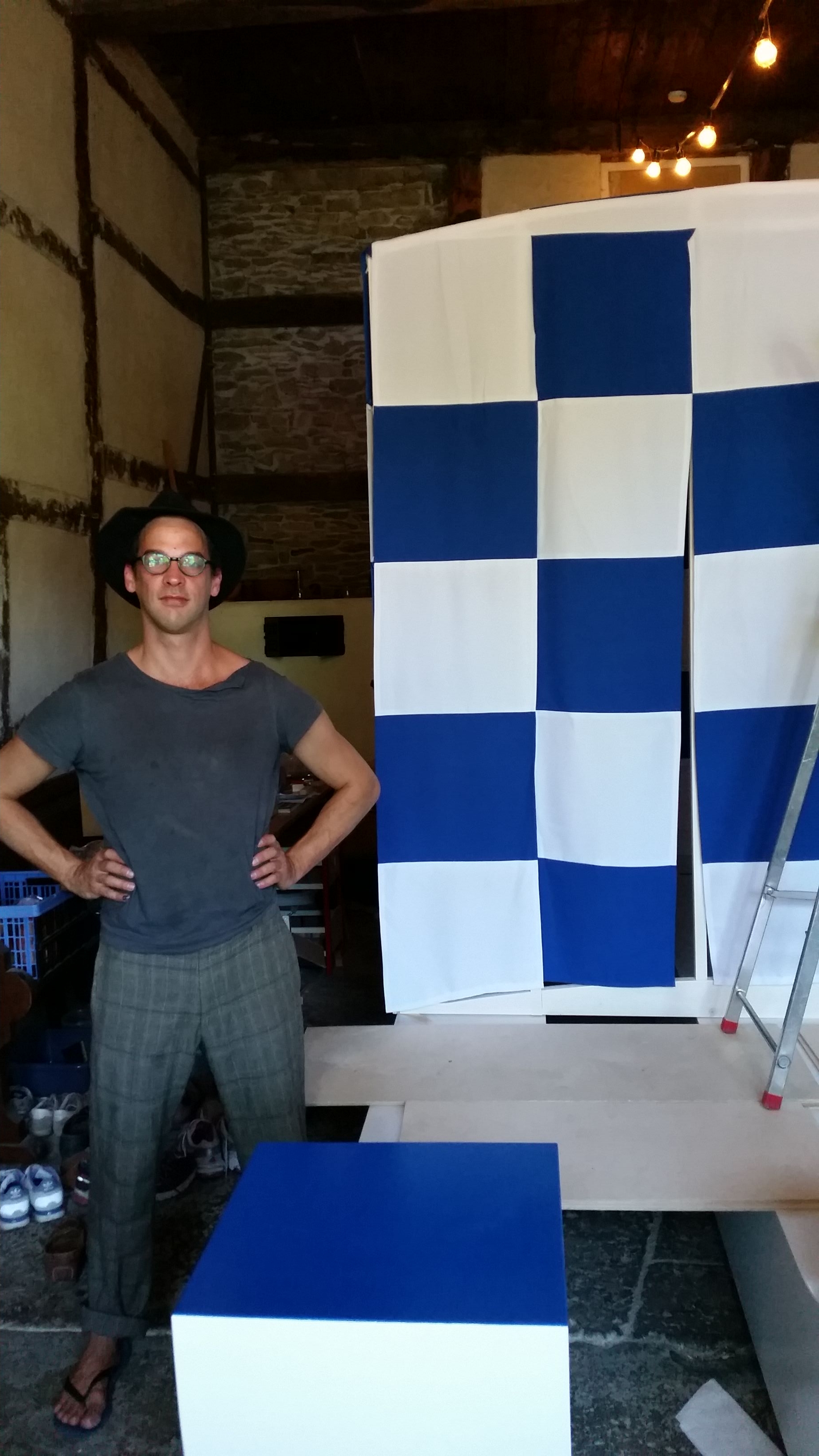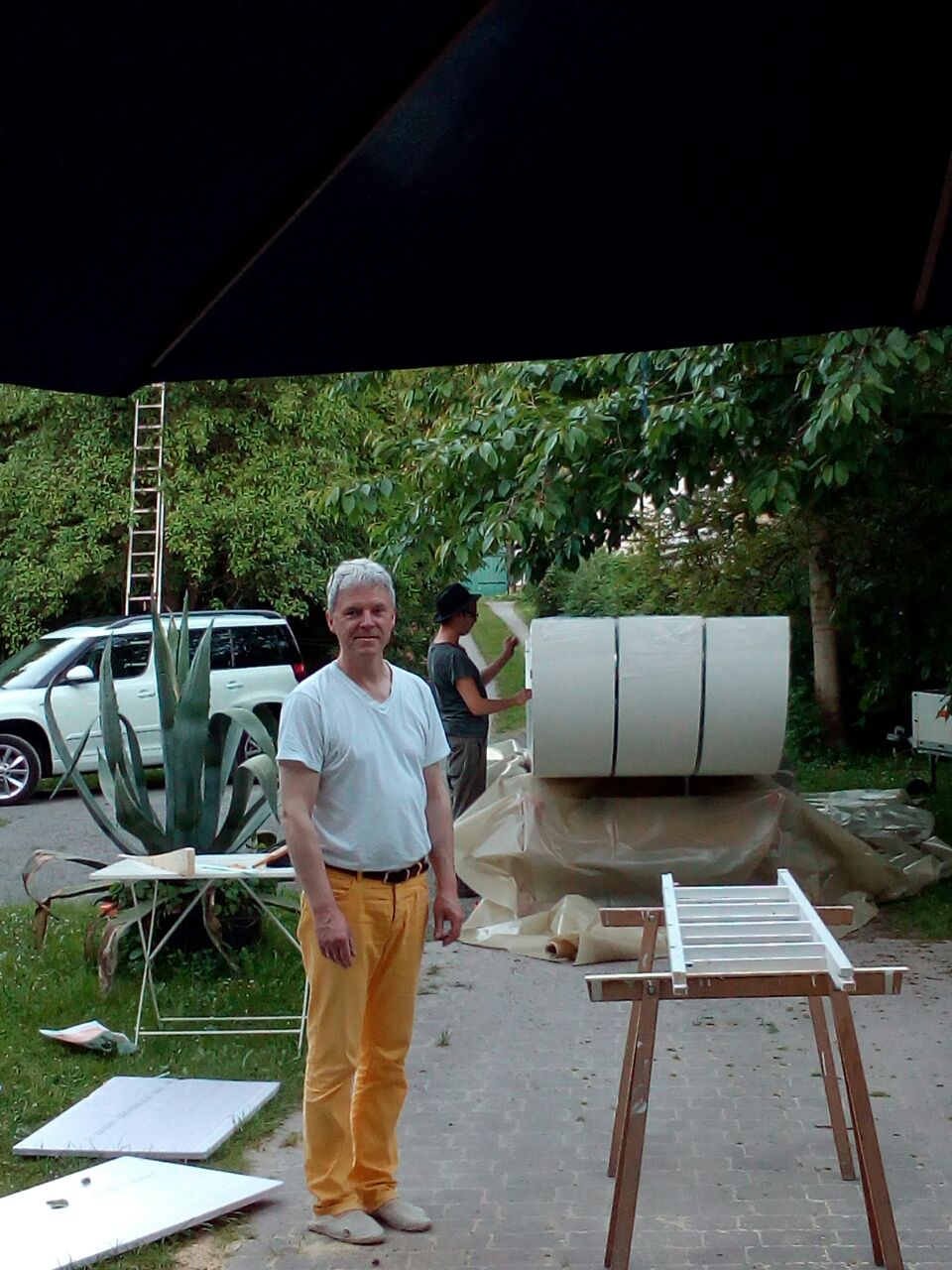Splav
Šibenik, Kroatien
01.–15.6.2017
Ein Kubus mit den Maßen 2 x 2 x 2 m bewegt sich auf einem Floß langsam über die Meeresbucht, an der die Stadt Šibenik liegt und wo der Fluss Krka in die Adria mündet. Von weitem entdeckt man den Würfel mit seinem auffälligen blau-weißen Schachbrettmuster. Das Floß, das ihn trägt, besteht aus drei länglichen Schwimmkörpern, die vorne und hinten hochgebogen sind. Es ist ebenfalls blau und weiß und hat die gleiche Breite wie der Kubus. Beide gehören zusammen; das Floß zeigt jedoch eine Bewegungsrichtung, während der Würfel still und richtungslos wirkt.
Der blau-weiße Kubus ist kein starres Objekt, sondern wie ein Zelt besteht er aus Stoff – eine bewegliche Hülle mit einem unauffälligen Eingang. Er ist ein optischer Anziehungspunkt, der etwas umhüllt. Doch er umhüllt nichts, er ist leer. In seinem Inneren gibt es keinen Thron, keine Monstranz, kein Objekt, sondern nur Leere, vom Umraum abgesondert, nichts von Bedeutung. Doch alle, die es sehen, spüren: hier ist etwas von Bedeutung.
Kaum jemand betritt diesen umhüllten Raum, man steht am Ufer und stellt sich das Innere vor. Man spürt den Gegensatz dieser kleinen Geschlossenheit zur weiten Umgebung. Der auffällige Kubus kontrastiert zur Oberfläche des Wassers, er setzt sich in Beziehung zur Stadt, zu ihrer Lage am Ufer, die sich hinaufzieht auf einen Hügel, und auch zu der großartigen Kathedrale des heiligen Jakobus, einem Weltkulturerbe aus der Renaissance. Unsere Aufmerksamkeit ist geweckt. Sie wandert aus der Hülle hinaus in die Umgebung. Alles wird zur Bühne. Die Ruhe des Floßes, seine auffällige Farbigkeit, die langsame und schwankende Bewegung – all das lenkt unsere Vorstellung. Es berührt sich mit dem Wasser, mit dem Himmel, mit dem Ufer. Der Anziehungspunkt unserer Blicke bleibt nicht stehen, er wird von den Wellen und der Luft bewegt, er landet am Ufer, er wird in einer Prozession durch die Stadt getragen, an der Kathedrale vorbei und weiter hinauf bis zur Kapelle des heiligen Chrysogonus, in deren Innerem er ausgestellt wird – mitsamt all den Vorstellungen, die er an sich gebunden hat. Wir sehen eine langsame und feierliche Prozession.
Selbst, wenn wir am 1. Juni 2017 nicht dabei waren: Wir stellen sie uns deutlich vor. Sie erinnert an viele Prozessionen, Schiffsprozessionen auf dem Wasser, Schiffe mit einem Gegenstand der Verehrung, auf Rädern über das Land gefahren, wie sie von den alten Ägyptern bis heute an vielen Orten durchgeführt wurden und werden. All diese Prozessionen transportieren ein heiliges Objekt. Entsteht aber ihre Faszination aus diesem Objekt? Das Großartige bei einer Prozession – ist es nicht vor allem der Raum, durch den sie sich zieht?
Hier, bei der Prozession des Schiffsobjektes „Splav“ von Harald Brörken, gibt es keinen Gegenstand der Verehrung. Das Objekt unserer Ausrichtung ist dieser Umraum, mit dem sich das feierliche, leere Behältnis im Einklang befindet. Mit seiner Ruhe, mit seinen Farben und seiner kubischen Konzentration „zeichnet“ das Schiffsobjekt das weite Wasser nach, es zieht eine Linie durch die Bucht, durch die Stadt, an der Kathedrale vorbei, zu der seine Kubatur eine besondere Beziehung herstellt. Das Schiff wird durch die Gassen und über die Plätze getragen, die Erinnerung an das Wasser bewegt sich über das Land. Als würde man all dies neu sehen. Doch wird es nicht nur gezeichnet. Es ist real. Und zugleich erlebt man, was schon lange da war, in neuer poetischer Dichte.
Erich Franz
Presse:
pomorac.net
sibenik.in
Soester Anzeiger 04.02.2017
Soester Anzeiger 26.05.2017
Harald R. Broerken: Projekt „Splav“, Šibenik,
Hrvatska, 1. – 15.6. 2017
Kubus od 2x2x2 m klizi polagano na splavu u uvali iznad koje leži grad Šibenik, tamo gdje se rijeka Krka izlijeva u Jadransko more. Kocka sa svojim napadnim plavo-bijelim uzorkom vidi se izdaleka. Splav koji ju nosi sastoji se od tri izdužena drvena tijela koja su na prednjoj i stražnjoj strani savinuta prema gore. Također obojan u plavo-bijelo, ima istu širinu kao kubus. Zajedno čine jedno tijelo, ali splav pokazuje smjer kretanja, dok kocka djeluje mirno i neusmjereno. Plavo-bijeli kubus nije kruti, statični objekt, već ima oblik platnenog šatora – pokretnog omota s nevidljivim ulazom. Riječ je o optičkoj točki privlačnosti, naizgled nešto obavija, no zapravo je prazan. U njegovoj unutrašnjosti ne nalazi se prijestolje, pokaznica, objekt, već samo beznačajna praznina odijeljena od okolnog prostora. Ipak, svi koji ga vide osjećaju kako se ovdje nalazi nešto značajno.
Rijetko tko zakorači u taj obavijeni prostor, ljudi stoje na obali i zamišljaju njegovu nutrinu. Osjeća se suprotnost između te male zatvorenosti i širine okoline. Napadan kubus nalazi se u kontrastu s površinom mora. Razvija se odnos s gradom koji se penje uz brežuljak prema veličanstvenoj katedrali sv. Jakova, spomeniku svjetske kulturne baštine iz doba renesanse i njegovim položajem na obali. Naša pažnja je pobuđena. Ona struji iz unutrašnjosti prema okolini. Sve se pretvara u pozornicu. Mir splava, njegova upečatljiva obojenost, lagani ljuljajući pokret – sve to upravlja našom imaginacijom. Splav je u dodiru s morem, nebom i obalom. Fokus naših pogleda ne zastaje na jednoj točki, već se kreće kroz valove i zrak, pristaje na obali, nošen jeprocesijom kroz grad pored katedrale i dalje uzbrdo do crkve sv. Krševana u čijoj će unutrašnjosti biti izložen zajedno sa svim predodžbama koje je vezao uz sebe.
Vidimo polaganu i svečanu procesiju. Kako nismo bili prisutni 1. 6. 2017, jasno je predočujemo: ona podsjeća na mnoge procesije, procesije broda na moru, brodova s predmetom obožavanja na kotačima dovedenih preko kopna. Tako se radilo do danas, a još uvijek živi i na mnogim mjestima u tradiciji starih Egipćana. Sve te procesije transportiraju sveti objekt. No moramo se zapitati nastaje li fascinacija kroz taj objekt? Zar nije veličanstvenost procesije prije svega prostor kroz koji ona prolazi? Kod brodskog objekta „Splav“, autora Haralda Broerkena, ne postoji predmet obožavanja i klanjanja. Objekt na koji usmjeravamo pažnju sama je okolina s kojom se svečani unutarnji prazni prostor usklađuje. Svojom tišinom, bojama i kubičnom koncentracijom, brodski objekt „ocrtava“ širinu mora i povlači liniju uvalom, gradom, pokraj katedrale prema kojoj njegova kubičnost razvija poseban odnos. Brod je nošen kalama i trgovima, sjećanje na vodu kreće se prema kopnu. Kao da to sve vidimo u jednoj novoj dimenziji. No to nije samo crtež, riječ je o realnosti. Ponovo doživljavamo ono što je već dugo potisnuto: novu poetsku zgusnutost.
Erich Franz
prijevod: Sanja Sašo
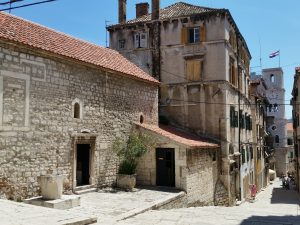
Galerija Sv. Krševana
Harald R. Broerken: Raft Project, Šibenik,
Croatia, 1st – 15th June 2017
A cube of size 2x2x2 m slides slowly on a raft in a cove above which lies the city of Šibenik, where the Krka River flows into the Adriatic Sea. The cube with its striking blue and white pattern can be seen from afar. The raft carrying it is comprised of three elongated wooden bodies that are bent upwards on its front and back side. The raft, painted blue and white, is as wide as the cube. Together they make up one body, with the raft showing the direction of its movement, whereas the cube appears calm and unoriented. The blue and white cube is not a rigid, static object but it is shaped like a linen tent – moving wrapping with an invisible flap. It acts as an optical point of attraction, it seems to be wrapping something up but in reality it is empty. In its interior there is no throne, monstrance or object, only an insignificant void separated from the surrounding area. Nonetheless, whoever sees it feels that something of great importance is in there.
Few are those who decide to step into that cloaked space; people prefer standing on the shore and imagining what the inside is like. A contrast between that slight closeness and the spaciousness of the surrounding area can be sensed. The striking cube stands in contrast to the sea surface. There arises a relationship with the city that climbs up the hill towards the magnificent Cathedral of St James, a World Heritage Site dating from the Renaissance and with its position on the coast. Our attention is caught. It flows from the interior towards its surroundings. Everything transforms into a stage. The peace and quiet of the raft, its striking colour, a light rocking motion – all this manages our imagination. The raft is in contact with the sea, sky and coast. Our view is not focused on one point only; it rather moves through waves and air, pauses at the pier, makes its way in the procession around the city, past the cathedral and up the street to the Church of St Chrysogonus, in whose interior it will be exhibited along with every conception related to it. We can see a slow and solemn procession.
Since we were not there on 1st June 2017, we want to present it clearly now: it resembles many other processions, boat processions at sea, these boats with an object of worship carried all the way from a sanctuary on land. This custom has been followed until today and it is still respected in many places in the tradition of the Ancient Egyptians. In all these processions a holy object is transported. However, we have to ask ourselves if that object produces fascination. Doesn’t the magnificence of a procession lie in the location where it takes place? The Raft, a boat-like object by Harald Broerken, does not involve an object of worship and idolatry whatsoever. The surroundings themselves that harmonize with the solemn void inside are the object to which we draw our attention. The boat-like object, with its peace and quiet, colours and cubic concentration outlines the spaciousness of the sea and draws a line through the cove, city, past the cathedral with which its cubicity nurtures a special relationship. The boat is carried around the little narrow streets and squares, the memory of water moves towards land. As if we were able to see everything in a new dimension. Yet, it is not a mere drawing, it is reality. We simply experience again what has been suppressed for ages – a fresh poetic condensation.
Erich Franz
translation: Joško Tošić
Vožnja do Šibenika 2017
Entwurf von 2016
making of, izrada

